Ruralite
NORTHERN WASCO COUNTY PUD
JUNE 2025

Faith and History Under One Roof
St. Paul’s Episcopal Chapel celebrates 150 years Page 4





















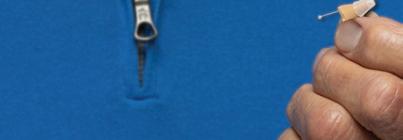

























JUNE 2025

St. Paul’s Episcopal Chapel celebrates 150 years Page 4














































June 2025 • Volume 72, No. 6
CEO Michael Shepard
SENIOR VP OF CONTENT Leon Espinoza
EDITORIAL DIRECTOR Chasity Anderson, CCC
DEPUTY EDITORIAL DIRECTOR
Noble Sprayberry
SENIOR EDITOR Jennifer Paton, CCC
ASSISTANT EDITORS Victoria Hampton, CCC; David Herder, CCC; Sable Riley, CCC
ASSOCIATE EDITORS
Valeri Saldanha Rosa, Nina Todea
PUBLICATIONS PRODUCTION SR. MANAGER
Elizabeth Beatty
SENIOR PUBLICATIONS COORDINATOR
Alyssa McDougle
Ruralite (USPS 397-460) is published monthly for members for $5.43 per year, plus postage, by Pioneer Utility Resources Inc., 5625 NE Elam Young Parkway, Suite 100, Hillsboro, OR 97124—a not-for-profit Oregon cooperative corporation—to serve the communication needs of 46 consumer-owned electric utilities in Oregon, Washington, Alaska, Idaho, Nevada and California. Preferred periodical postage paid at Hillsboro, Oregon, 97123 and additional mailing offices. © 2025 Pioneer Utility Resources. All rights reserved. Reproduction in whole or in part without written permission is prohibited.
Postmaster: Send address changes to Ruralite, 5625 NE Elam Young Parkway, Suite 100, Hillsboro, OR 97124-6454
HOW TO CONTACT RURALITE
Subscription services:
Nonmember subscriptions $15 (U.S.) per year; $25 per year (foreign). Prepayment required. Allow 4-8 weeks for first issue. Be sure to identify which local edition you want to receive.
Address Changes:
Utility members, contact your local utility. Subscribers, call us at 503-357-2105, option 3, or email mailingdept@pioneer.coop.
Back issues:
Back issues and extra copies are $3. Prepayment required. Supply is limited. Be sure to identify edition, month and year. Call first if ordering back issues to check availability.
To contact Ruralite: Ruralite magazine is published by Pioneer Utility Resources, P.O. Box 1306, North Plains, OR 97133-1306; 503-357-2105; email: info@pioneer.coop. For more information, visit pioneer.coop.
DISPLAY ADVERTISING INQUIRIES
American MainStreet Publications
611 S. Congress Ave., Suite 504
Austin, TX 78704
800-626-1181 or 512-441-5200

For supplemental and interactive content, search @Ruralite on your favorite social media sites.
There’s something captivating about discovering the unexpected in the ordinary.
In this month’s issue, we’re drawn to stories of people who’ve found joy, purpose and community in places they never anticipated.

Take Paul Swanson, who stumbled across a YouTube video of magnet fishing and found not just a hobby, but what he calls his “soul savior.” Living with progressive multiple sclerosis and raising two children with autism, Paul transformed a simple activity into a meaningful pursuit that connects him with friends, cleans local waterways and reveals history hidden beneath the surface.
We also explore communities that celebrate their distinct character through what can only be described as delightfully unconventional festivities. From Alaska’s Outhouse Races— complete with custom privies on skis—to Idaho’s Silver Wake Celebration showcasing handcrafted wooden boats, these gatherings remind us that tradition often walks hand in hand with eccentricity.
Even the everyday tortilla becomes something extraordinary in our kitchen section, where Gertrude Treadaway shows us how this simple staple can be transformed into everything from pizza quesadillas to taco lasagna. Sometimes the most accessible ingredients offer the greatest creative possibilities.
There’s a refreshing authenticity in these stories—people finding their way to passion and community through unexpected avenues.
As summer begins, I find myself inspired to look for the extraordinary hiding in plain sight. Perhaps there’s a local tradition I’ve overlooked, a hobby I’ve dismissed or a simple pleasure I’ve forgotten to appreciate. I hope this issue encourages you to do the same—to celebrate the unexpected treasures in your own community.
Until next time, Chasity Anderson Editorial Director
What unexpected discoveries have you made in your community? We’d love to hear about the extraordinary elements that make your area special. Maybe you’ll even see a story about it in an upcoming edition! Reach me at editor@pioneer.coop.
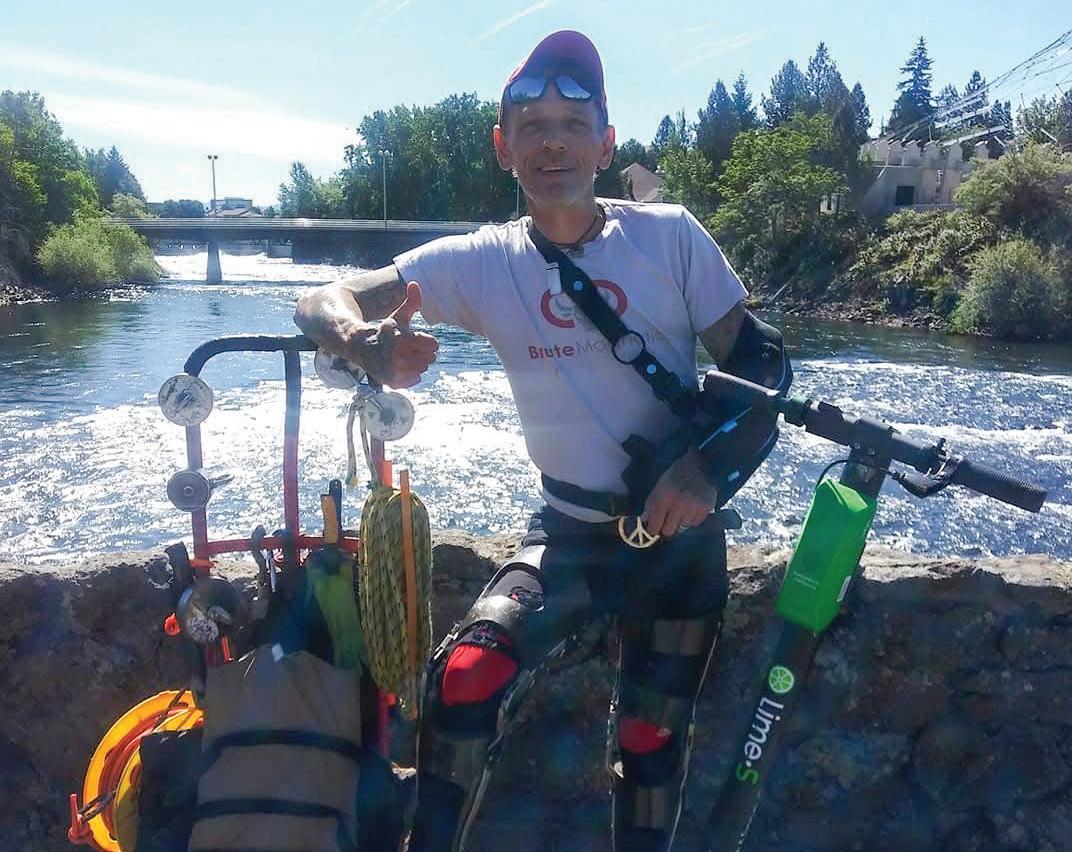
Paul Swanson’s magnet fishing journey transforms disability into discovery
Up Close, Page 10
Spotlight, Page 12
Turn to tortillas
In The Kitchen, Page 16
By Rodger Nichols
The newest point of interest in The Dalles is one of the town’s oldest buildings. The modest but well-preserved carpenter Gothic building at Fifth and Union streets is the original home of St. Paul’s Episcopal Church.
A Cornerstone of the Community In 1875, The Dalles boasted a population of more than 1,000, and the congregation of the Episcopal church had grown so large that meeting in people’s homes was no longer practical. Episcopal Bishop of Oregon Benjamin Wistar Morris purchased land to build a church for $50 in gold coins. Today, that amount of gold would be worth more than $8,000.
The cornerstone was laid May 28, 1875, and the first service was held on Christmas Day that year. The church celebrated its 150th anniversary this year—on May 28, naturally—with a communitywide celebration featuring worship, music and refreshments.
The church was nearly lost long before reaching that milestone. On Sept. 2, 1891, the worst fire in the history of The Dalles destroyed 17 city blocks and hundreds of homes. The Methodist, Baptist and Congregational churches were all lost in the blaze, but the fire stopped just a few feet from St. Paul’s.
The building was expanded several times throughout its history, including the addition of Remington Hall. However, the congregation eventually outgrew the facility and constructed a much larger church at 1805 Minnesota St. in 1962. The congregation began referring to its previous church as “the chapel.”
Gretchen Kimsey is the perfect person to pick up the story as it enters living memory territory. She and her husband, the late Rev. Rustin Kimsey, moved to The Dalles from Baker City when he became rector of St. Paul’s.
“We moved here in the summer of ’71,” she says. “Right away, Rustin decided to have Holy Week services here in the chapel. The chapel had not been used in the 1960s because the St. Paul’s on the hill was finished in1962.”
In the decade the chapel was rarely used by the congregation, the building served as a Red Cross facility and Remington Hall housed a geology museum.
“The chapel had been used
wedding, sometimes a funeral. Usually during Holy Week, before Easter, there would be services here, always on Christmas morning.”
Although the first Christmas Day service at St. Paul’s was held nearly a century before Gretchen and her husband arrived in The Dalles, the event was so memorable that the tale was passed down for generations.
“The story goes that the side windows that arrived just a day before Christmas were the wrong size. And so, the men got together and figured out a way to have the windows be installed so that a wood
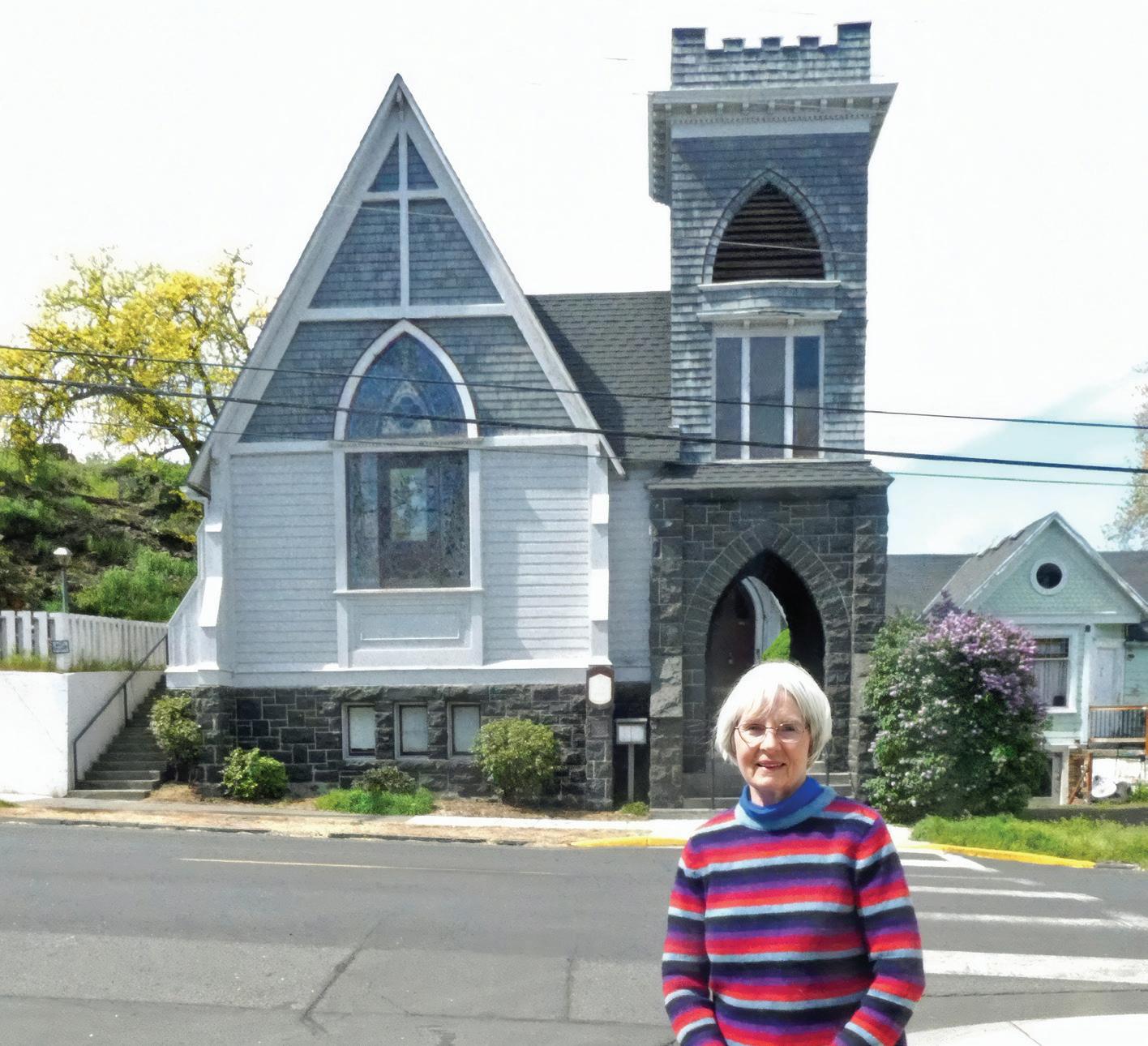
stove—which was the only source of heat at that time—could be lit. And the interior of the chapel at least warmed above freezing,” Gretchen says. “That was the very first service held here at the Chapel at St. Paul’s. And Rustin revitalized that tradition in 1971. Christmas services have been in the chapel at 10 a.m. every year since.
“During the years that Rustin was bishop, I prepared food and hosted a Christmas party every year here for the community,” she adds. “People could come, we’d have a roaring fire in the fireplace, and I served Danish kringle and wassail. That was something I loved to do.”
The chapel gained a new purpose in 1980, when Rustin became Episcopal Bishop of the Diocese of Eastern Oregon.
“The actual ordination was at The Dalles High School in Kurtz gymnasium,” Gretchen says. “After the ceremony, the police had Union Street cordoned off, and everybody who was able walked from the high school, down the middle of the street to the chapel, where it was rededicated as the Episcopal Diocese of Eastern Oregon’s official home.
For the next 20 years, until Rustin retired in 2000, his office was there. The diocesan archives were also stored in the building. The archives remained in a back office at St. Paul’s Chapel until recently, when the materials were moved to Cove, where the diocese maintains its Ascension School and summer camp facilities.
“A deacon, Georgia Giacobbe, was our archivist,” Gretchen says. “She would come on a regular basis here and research and catalog and do what archivists do.”
“Now we are exploring other best uses for Remington Hall and for the chapel,” Gretchen says. “We hope that the chapel will remain a place of worship and a place where people can gather for significant events. And Remington Hall can be used in a variety of ways, such as meeting space for various groups, and the little office spaces could be possibly used by nonprofit groups or for a fledgling business of some kind.”
She also says the congregation is prepared to open the chapel as a tourist
We hope that the chapel will remain a place of worship and a place where people can gather for significant events.
The congregation continues to use the chapel for regular Wednesday noon services and special services during Holy Week and on Christmas. But Episcopalians are not the only faith community using the building. A Quaker congregation meets there twice a month.
With the removal of the archives, the diocese no longer has an interest in maintaining ownership of the building and property, and there are plans for the local congregation to purchase it.
— Gretchen Kimsey
attraction. A brochure has been prepared, laying out all the points of interest in the building, including the stained-glass windows made by the Povey Brothers of Portland, one of the premier glass studios in the Northwest.
“I see the chapel as a place of outreach to the community to visit, and also find comfort and peace,” Gretchen says. “As a historic building, St. Paul’s Chapel has a long and interesting story to tell.” n
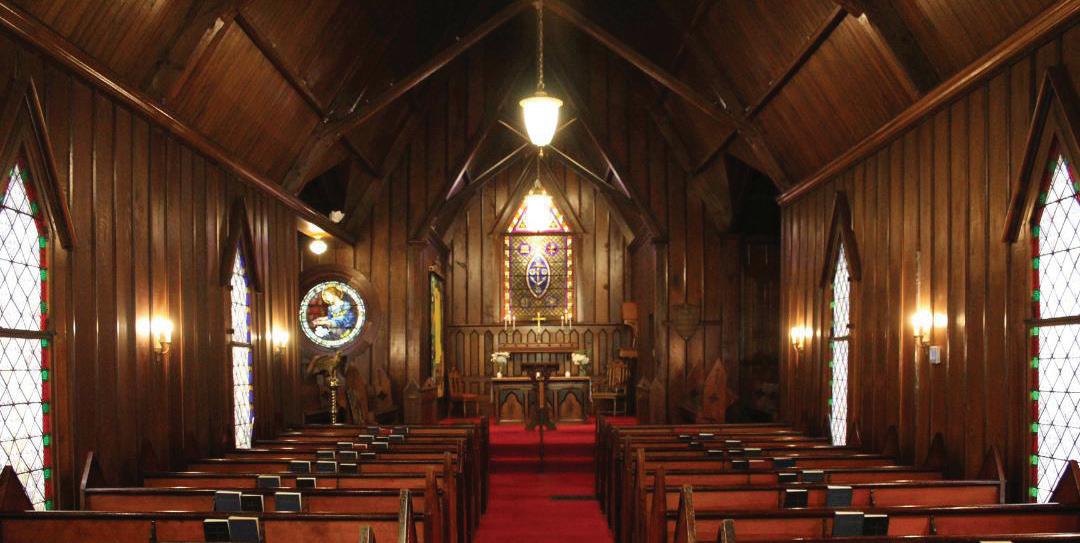
By Sable Riley and Michael Leitman
America’s appetite for energy never takes a break—and neither can the power grid. That reliability stems from a diverse energy mix. Across the country, electric utilities depend on coal, natural gas, nuclear, wind, solar, hydropower, biomass—from organic waste like wood chips—and geothermal sources to keep the power flowing.
Energy Mix by the Numbers
According to the U.S. Energy Information
Administration, natural gas is the leading source of energy, generating about 43% of the United States’ electricity in 2023, the most recent statistics available.
Coal, once dominant, has fallen to about 16%. Nuclear produces roughly 18%, delivering reliable baseload power. Renewables continue to grow. Wind contributes about 10%, hydroelectric dams about 6%, solar farms 4%, and biomass and geothermal together account for 1-2%.
Altogether, renewables make up just more than 20% of the mix. This balance—60% fossil fuels, 20% nuclear and 20% renewables— leverages the strengths of each resource.
Electric utilities embrace an
all-of-the-above strategy. Jim Matheson, CEO of the National Rural Electric Cooperative Association, says diversity of electric generation, including baseload sources, is essential to providing dependable, affordable power.
Utilities use what’s local and available— hydro in the Northwest and solar in the Southwest—and exchange power regionally to stay flexible.
Some sources can be turned on when needed; others can’t. Dispatchable sources like natural gas, coal and hydropower—if
Energy choices—and the sheer volume of power produced— swing wildly once you break the country into the four Census Bureau regions. This map shows each region’s 2023 electricity output, then stacks the fuel mix so you can see who leans on gas, who burns coal, and where wind, solar and hydropower dominate from coast to coast.
• Natural Gas: 25%
• Coal: 32%
• Nuclear: 12%
- Wind: 24% - Solar: 3%
- Hydropower: 3%
• Renewables: 31%
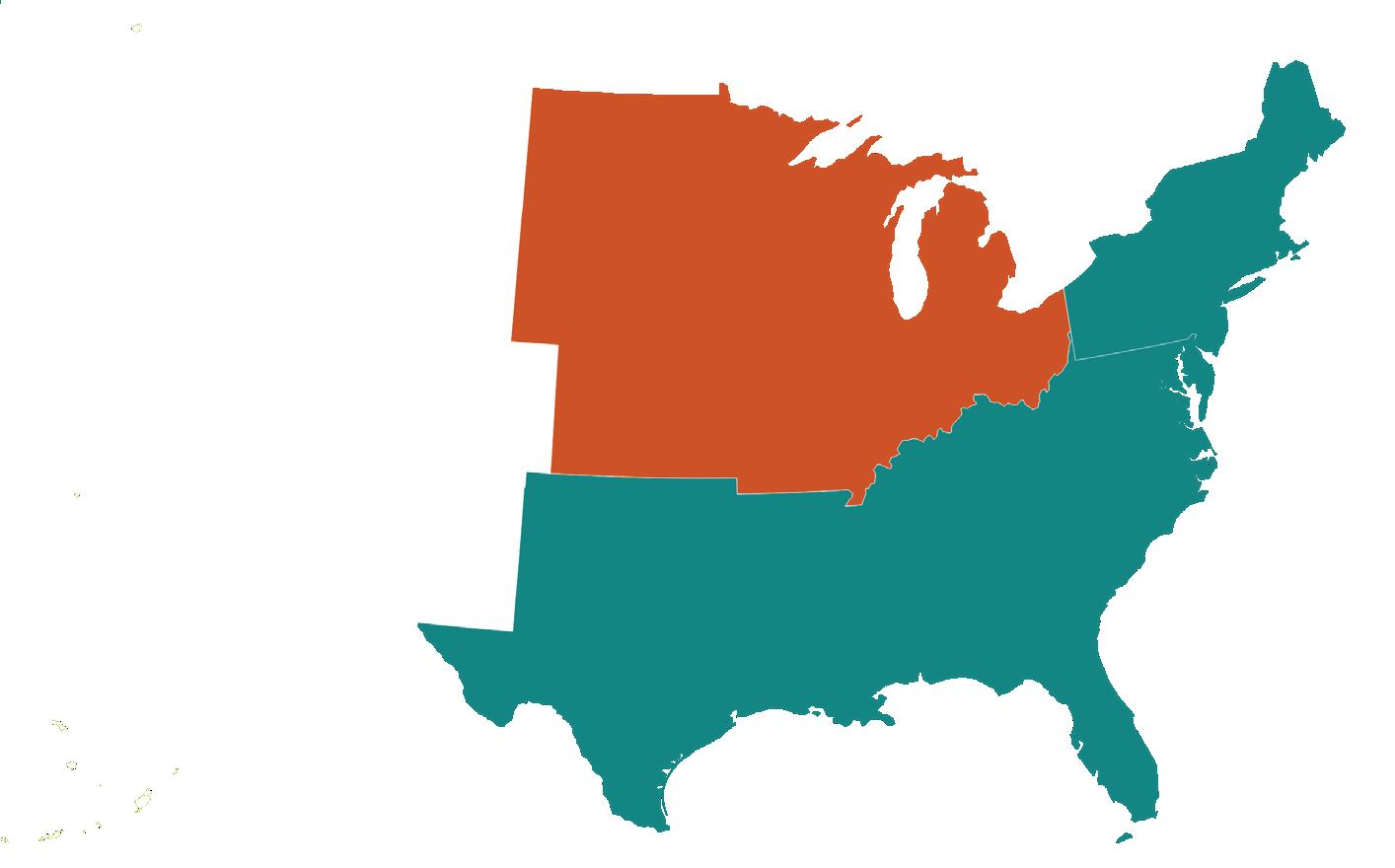
NOTE: Percentages are approximate shares based on the most recent data available from the U.S. Energy Information Administration utility-scale net generation. *Other renewables combine biomass and geothermal fuel data.
• Natural Gas: 30%
• Coal: 10%
• Nuclear: 4%
• Renewables: 56%
- Wind: 14%
- Solar: 18%
- Hydropower: 22%
- Other: 2%
• Petroleum: 1%
- Other: 1%
Northeast (524 TWh)
• Natural Gas: 47%
• Coal: 5%
• Nuclear: 29%
• Renewables: 18%
- Wind: 5%
- Solar: 4%
- Hydropower: 8%
- Other: 1%
• Petroleum: <1%
South (1,934 TWh)
• Natural Gas: 45%
• Coal: 18%
• Nuclear: 17%
• Renewables: 19%
- Wind: 9%
- Solar: 6%
- Hydropower: 3%
- Other: 1%
• Petroleum: 1%

those resources are available—ramp up and down on command, responding instantly to demand changes. In contrast, nondispatchable sources like wind and solar depend on weather. A reliable grid needs both types working in concert. On a sunny afternoon, solar farms may flood California’s grid with power. At sunset, fast-start gas and hydroelectric plants take over.
“The growth of renewables has had many benefits, but the wind doesn’t always blow, and the sun doesn’t always shine,” Southwest Power Pool’s Paul Suskie said in a 2023 congressional testimony on grid security. Grid operators must rely on other fuel sources to ensure demand can still be met, Paul said. Real-world events underscore this interplay.
During California’s 2022 heat wave, battery storage systems and gas plants met peak evening demand after solar generation declined. Conversely, Winter Storm Elliott in December 2022 caused blackouts in parts of the Southeast when more than 100,000 megawatts of coal and gas capacity failed during freezing conditions. That crisis revealed the risk of over-reliance on a single resource.
Electricity demand is also skyrocketing, fueled by new data centers and a surge in domestic manufacturing.
According to the North American Electric Reliability Corp., electric demand growth is now the highest it has been in more than two decades. Over the next 10 years, peak power
needs are expected to rise by more than 18%, with new projects driving demand even higher. That puts grid reliability under the microscope.
Regulators at the Federal Energy Regulatory Commission and at the state level are adjusting policies to support capacity, storage and demand response. In 2024, FERC Commissioner Mark Christie warned the United States is heading for a catastrophic situation in terms of reliability if changes aren’t made carefully during testimony before the House Subcommittee on Energy, Climate, and Grid Security.
The nation’s energy mix is shifting, driven by economics, innovation and policy choices. Federal incentives from the 2022 Inflation Reduction Act accelerated investments in solar, wind, batteries and advanced nuclear. At the same time, environmental regulations are prompting closures of older coal and gas plants.
NERC’s 2024 assessment cautions that rising demand combined with shrinking
LEFT: Renewable energy sources like solar and wind provide many benefits and can deliver low-cost electricity, but they only generate electricity when the sun shines or the wind blows.
baseload capacity puts many regions at risk of shortfalls during extreme conditions— even after recent solar and storage additions.
Energy storage is a promising development. Batteries help balance intermittent renewables by storing surplus energy and releasing it when needed. Battery capacity in the United States jumped 66% in 2024 to roughly 26 gigawatts and could nearly double again by the end of 2025, according to the U.S. Energy Information Administration.
No single energy source can guarantee affordable, uninterrupted electricity across a country as vast and weather-diverse as the United States. Natural gas is flexible but susceptible to supply disruptions. Coal and nuclear plants offer consistent output but are less adaptable and aging. Wind and solar, while clean, depend on weather, and storage solutions remain limited.
Having a range of energy resources safeguards against any one fuel becoming scarce, expensive or unexpectedly unavailable.

That’s why electric utilities continue to invest in a balanced portfolio of energy sources—diversity gives the grid the resilience it needs to meet demand in the moments that matter most. n

Freshly planted and carefully tended, vegetable gardens can quickly become a magnet for trouble. Weeds, for instance, can overtake a garden in days. Slugs munch on seedlings. Aphids suck the juices from any number of plants.
If you haven’t planted yet, prepare the soil, then wait a week or two until weeds germinate. Loosen them with a hoe when they are still small, about the time two true leaves appear. Wait until another wave of weeds pops up, remove them, and you have a fairly clean slate for vegetables. Stay on top of emerging weeds until plants get big enough to shade them out.
Just like weeds, the sooner you deal with pests or diseases, the easier it is to control them. Slugs are one of the most common plant-eating pests. They especially gravitate toward lettuces and anything in the cabbage family but will make a meal out of just about any vegetable plant.
Throw slugs in a bucket of water or use the iron phosphate bait Sluggo. Traps work, too. Bury a small, plastic container up to about 1 inch from the rim. Fill it with beer, and remove the dead slugs daily.
Cucumber beetles are one of the most aggravating pests. About a quarter-inch
long and yellow with black spots or stripes, the cucumber beetle is an enemy of cucumbers and squash. They chew holes in leaves, eventually killing the plant.
Control cucumber beetles with good hygiene and vigilance. Clean up the garden at the end of the season, and keep it neat. Right after planting, use floating row covers, which are made of lightweight fabric that allows air, light and water through. Drape them over a hoop structure, and seal edges by burying them in the soil or using rocks or bricks. The covers are available online and from garden centers. Remove them once the crop starts flowering.
If you’ve already planted and see cucumber beetles, consider getting a few new transplants and starting over with the row cover. Pesticides aren’t effective because the beetles move too fast.
Aphids are small, usually light green and sometimes sport a fuzzy coat. They feed on plants by sucking the juice out of leaves and producing a sticky substance.
Monitor plants often, being sure to check the underside of foliage where aphids like to congregate. To control mild populations, squish or wash them off with a spray from a hose. For more moderate infestations, use
commercially available insecticidal soaps. Encourage natural enemies, like ladybugs, lacewings and hover flies, by not using broad-spectrum pesticides and planting a diverse variety of plants.
You likely will harvest broccoli, cabbage and other brassicas planted in early spring before the aphids get to them. They are at their worst in July and August.
Also a fan of the brassica family is the cabbage butterfly. These white, fluttery butterflies lay eggs on the undersides of leaves. When the larvae emerge, they tunnel into the hearts of cabbages.
Because they tend to be the same color as the leaves, cabbage butterfly larvae are hard to see. A row cover can help prevent the butterflies from laying eggs on crops. If it’s too late, consider using an insecticidal soap or a product with Bt (Bacillus thuringiensis), a naturally occurring bacteria that feeds on larvae. Another option is to plant a new crop topped with a row cover from the get-go. Only remove it temporarily for harvest. n
Visit tinyurl.com/7by2sp5j for more details. Information courtesy of Oregon State University Extension Service.



















By Ginger Meurer
Around 2019, Paul Swanson stumbled across a YouTube video of Magnetic Mike hurling a high-power magnet into Florida waters to fish for metal.
“That one video, I was hooked,” Paul says.
With a background in construction and angling, Paul saw magnet fishing as a beautiful blend.
“Once I threw a rope with my magnet, it was all over with,” he says. “I’ve never been so happy to pull up a horseshoe in my life.”
That first horseshoe hangs from a plaque bearing the inscription, “Everybody needs a little luck,” in Paul’s Spokane, Washington, living room.
‘Soul Saver’
Magnet fishing was more than lucky for Paul.
“I call it my soul savior,” he says.
Paul has progressive multiple sclerosis and is raising two children with autism.
“I needed something to do that wouldn’t break the family’s budget,” he says. “And our water is so rich in history, I just had to see.”
Waterways surround Paul’s home. From the 111-mile Spokane River to more than 86 nearby lakes, he says it’s impossible to run out of places to explore.
“We had the great fire of Spokane back in the early 1900s,” he says. “There’s so much stuff in that waterway, in anybody’s waterways. It’s just never been seen.”
Paul teamed with other magnet fishing enthusiasts and the Spokane Riverkeeper organization to help clean up the surrounding waterways.
“I’ve fought very hard not to be in a wheelchair,” he says. “So, now I go around with crutches and a bilateral brace, and I surround myself with a lot of warrior friends.”
There are at least four longtime regulars who meet around once a month, and as many as 700 more magnet anglers pitch in on big projects, like the time they tried to set a World Record, bringing in more than 14 tons of findings.
Friends help gear Paul up to set out aboard his double-hulled Livingston, where they throw and pull from over the boat’s edge.
“They’re all good swimmers. Nobody would let me go,” Paul says. “They keep a good eye on me. My wife’s pretty happy about that.”
Paul’s friends call him Mag Neto.
“Because I’m a magnet fisherman and because of my legs and everything else,” he says. “It just kind of stuck with me.”
Plenty has stuck to Paul’s magnet. He and his buddies have fished up just about everything, from Model-T rims to bathtubs, shopping carts, bicycles, electric scooters, phones, knives and even a few historic guns.
It isn’t about profit or treasure hunting for them. In fact, they end up donating the proceeds from most of their finds to charities. If owners are traceable, they return items, too. Often, they’ve been called on to help retrieve lost items. Occasionally, they even rescue newbies in need.
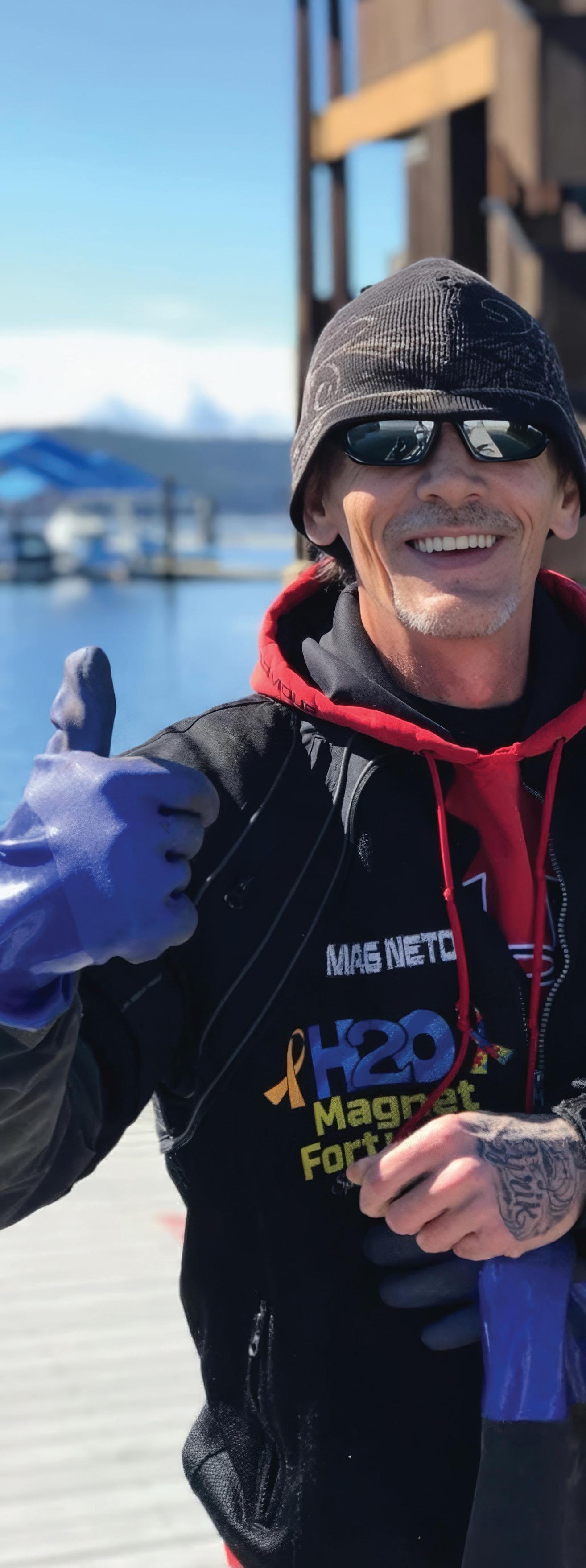
“You gotta help them out sometimes,” Paul says. “They just don’t realize that if they’re on a metal bridge and they throw out a magnet, it slaps to the side of it. There are ways to get it off, and we’ve mastered it.”
When people are looking for gear or tips, Paul sends them to Muscular Magnetics, a company launched about seven years ago in Orem, Utah, and is now based in Idaho Falls.


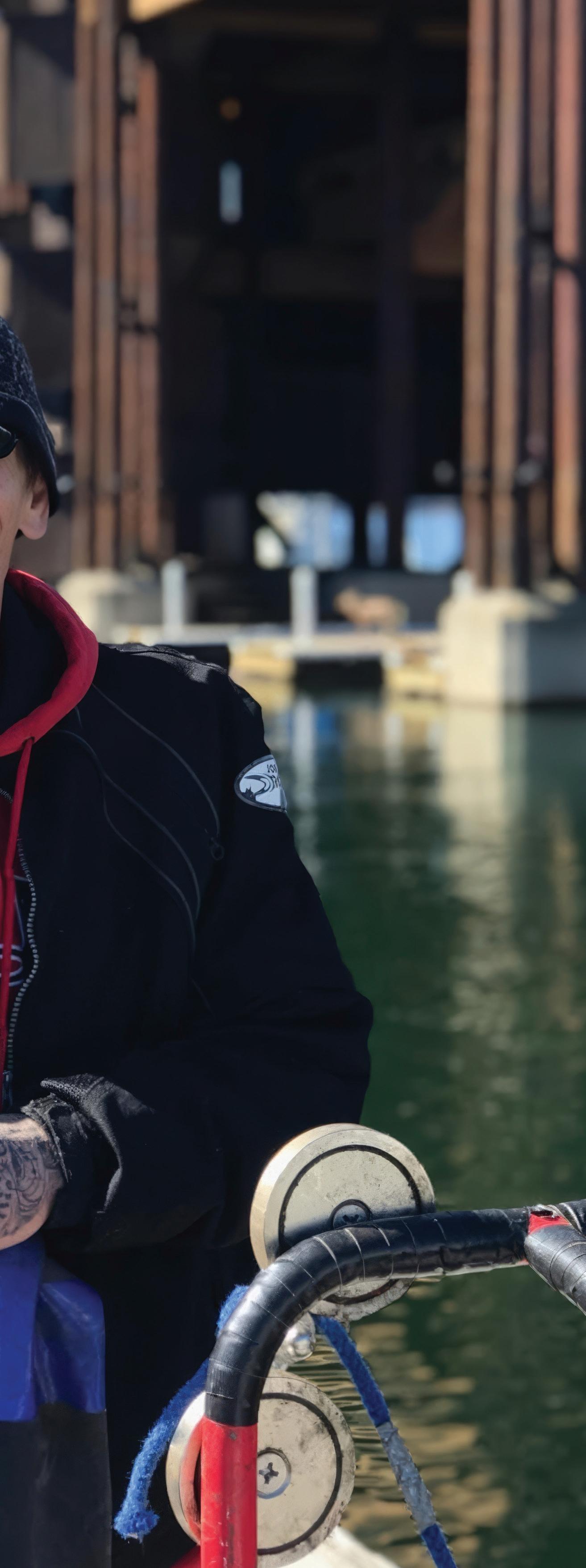
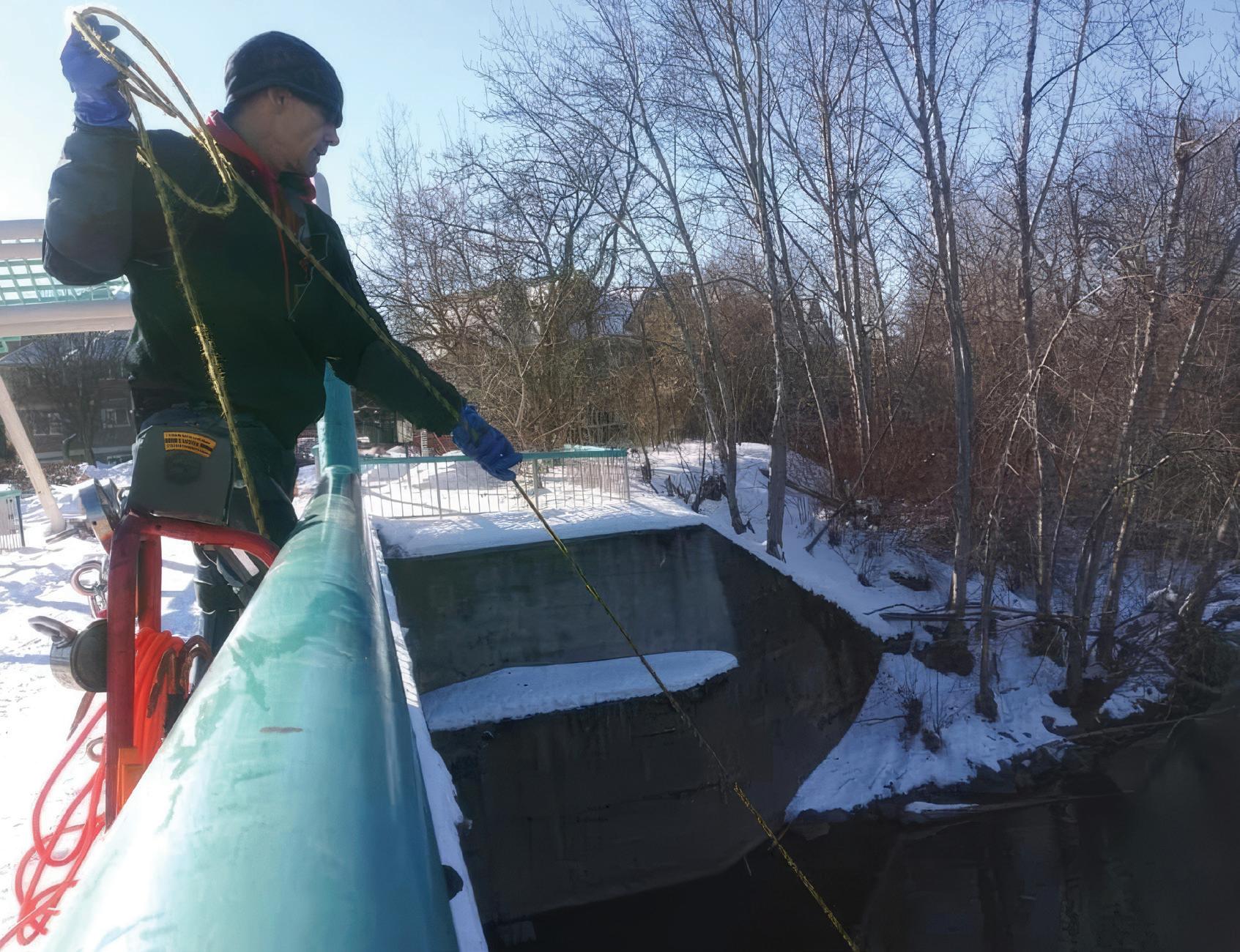
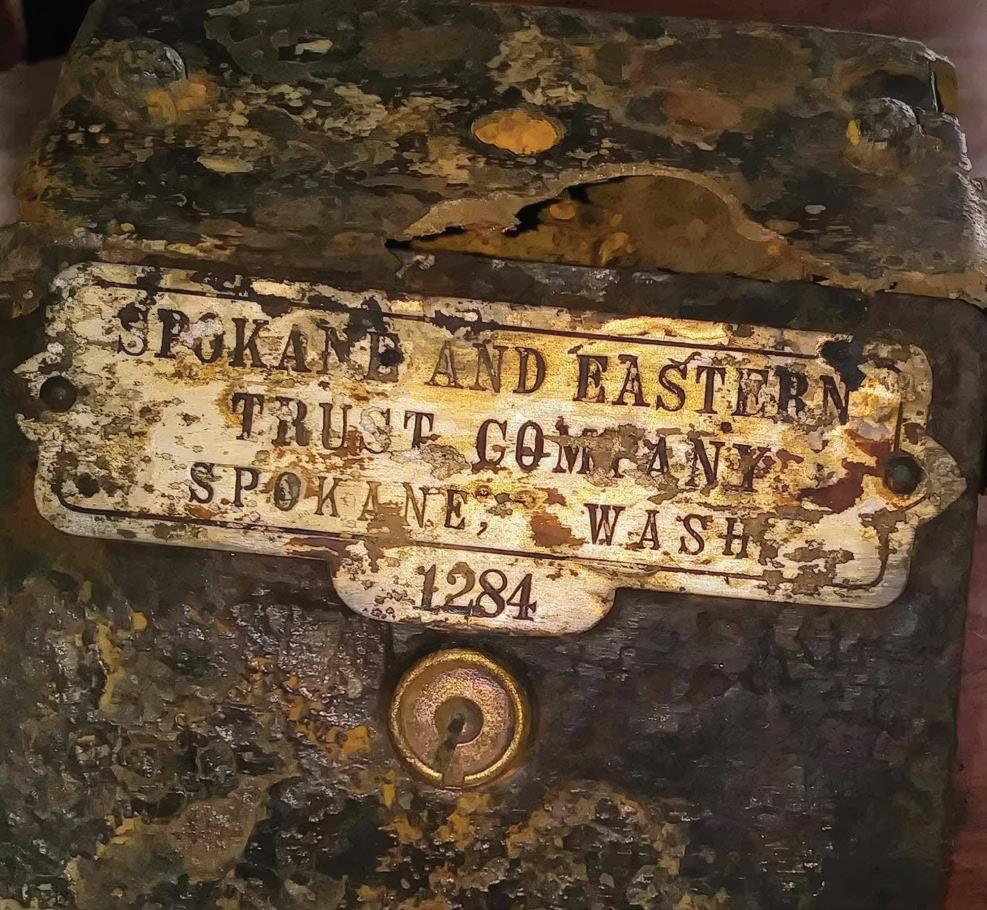
“Once you get the idea, oh, you’re essentially underwater metal detecting, it sparks the interest,” he says. “People wonder, ‘What can I find?’ We have had customers that have pulled some extraordinarily awesome things out of the water.”
Paul says magnet fishing isn’t for everyone and stresses that high-power magnets are not toys. If you have a pacemaker, this is not the hobby for you. Hearing aids are magnet-sensitive, too.
“And don’t put your phone near it, or you’re going to wipe it clean,” Paul says.
He also recommends respecting the waterways. He avoids indigenous areas and stays clear of places where fish spawn. Former battle areas are also a hazard.
Muscular Magnetics owner Michael Taylor built a great relationship with Paul.
“The moment I talked to Paul, he knew everything you could imagine about magnet fishing, probably better than I did, honestly,” Michael says. “He’s done great things where he is up in Washington.”
Michael says magnet fishing took off during the pandemic with people wanting to get out more, and that interest hasn’t diminished. The moment people see it, they want to know more.
The top of that list includes a convenience store ATM retrieved from the waters separating New York and New Jersey. Magnet fishing enthusiasts have discovered live bombs that required the bomb squad. Then there are handguns, shotguns, and even a couple of sniper rifles fished out by a grandfather and his grandson in Florida.
Muscular Magnetics and several competitors offer kits with everything from low-power magnets for beginners to high-power double-sided magnets that can lift thousands of pounds.

Michael says so far, there’s only one state with laws against magnet fishing: South Carolina.
“Really, any other state is game on as far as laws go,” he says. “Any public property, from what we’ve seen, is great for it.”
Paul recommends you ask first, even on public land.
“It’s a lot like a hunting sport,” Paul

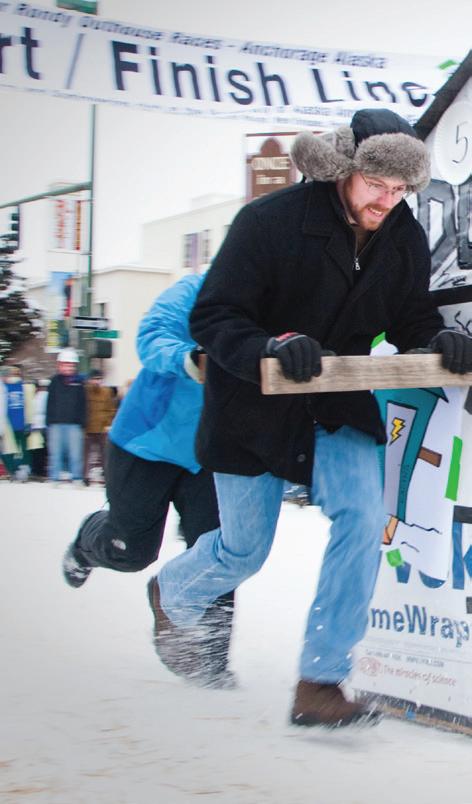



Festivals showcase communities' unique charms, characteristics and senses of humor. Attractions and events run the gamut from outhouse races to gravity-fueled coaster races, a Bigfoot calling contest to Basque dances and strength contests, and handcrafted mahogany boats of yesteryear to colorful kites to banana slugs.
Imagine an outhouse shaped like a fighter jet. That was one of the unforgettable entries in Anchorage’s annual Outhouse Races. The contest, held on the last Saturday of February, is a highlight of the two-week Fur Rendezvous—a prelude to the Iditarod and celebration of all things Alaskan.
a maximum of 12 feet in length and 8 feet in width and height. The categories were set in 2006, when the University of Alaska’s Architecture and Engineering Club started the event as a fundraiser.
Coeur d’Alene as water taxis, racers, or mail and grocery delivery, or for pleasure. He was known for his distinct boats and using blueprints of a Hacker-Craft design. They’re low in the water, so they have a smooth ride.”
Ron and his son are restoring another boat his uncle built named Skippy Junior.
“We work on it a couple of nights a week,” he says. “He was an amazing craftsman.”
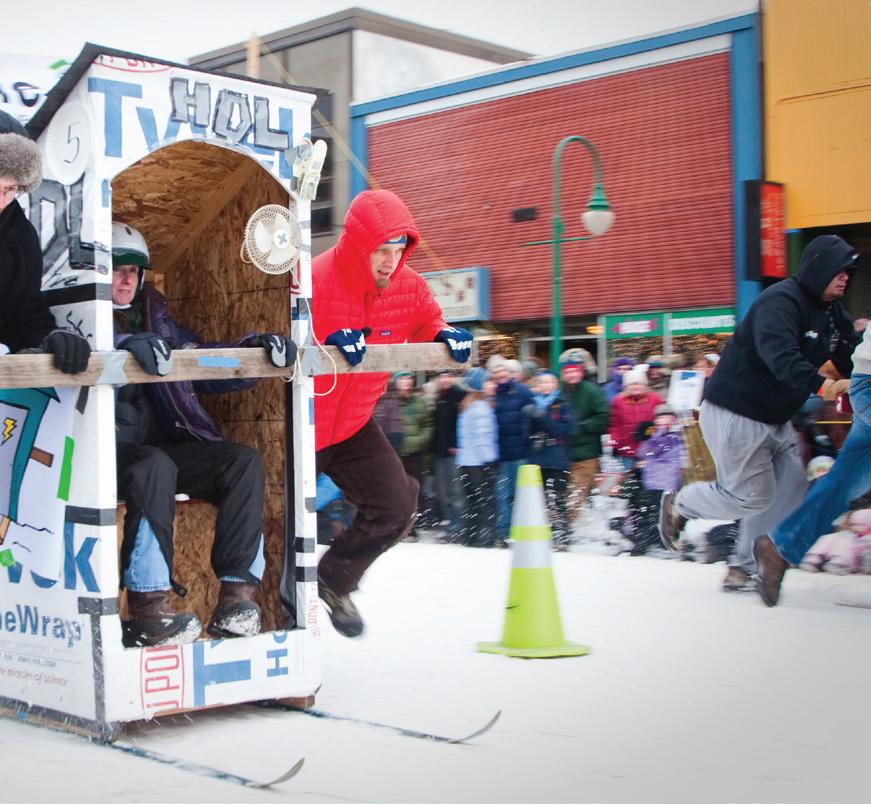

The “Top Gun”-esque outhouse was built by the Alaska Air National Guard team.
“There are so many hilarious, crazy entries,” says John McCleary, executive director of the festival, known locally as Fur Rondy.
Dozens of creative teams build an outhouse on skis and race it around a course, pulling and pushing it toward the finish line. Teams of four runners and one rider—who must wear a helmet and have toilet paper on board—choose between two categories when they build their peculiar privies. In the traditional class, outhouses must measure at least 30 inches square. The unlimited class allows
Along with prizes for the fastest and last-place finishers, there are awards for best theme, most realistic, cleanest and best engineered. Along with bragging rights, the winners receive a trophy like no other—a toilet paper roll holder ensconced in a small-scale outhouse.
The outhouse races are among more than two dozen events brightening spirits during the darkness of winter. Another crowdpleaser is The Blanket Toss, when people grip the edge of a taut, tanned walrus skin and toss someone in the center skyward. Also popular are ice sculpture contests and the Running of the Reindeer, where entrants dash down a street with deer hot on their heels.
The event is a fundraiser for the Three Barons Renaissance Fair, scheduled for the first two weekends in June with pirate and fantasy themes. Sword fights, crafts and food booths are featured.
There’s a backstory to the names of dozens of handcrafted wooden antique and classic boats that line up at Sandpoint's boardwalk during the Silver Wake Celebration, an annual boat show in mid-July in Northern Idaho.
“Our boat was called the Donna Rosa for my red hair,” says Jan Keener, show chairperson. “I’ve always loved the sound of the motor, the beauty of the boats, and the lasting friendships and camaraderie of boaters.”
The sleek boats’ white oak frames are covered with mahogany and varnished to a glistening shine.
“They all have a story,” says longtime boater Ron Yandt, who owns the Uncle Bob. “It was named for my uncle, who built about 75 boats that were used on Lake
The Inland Empire Chapter of the Antique & Classic Boat Society hosts three summer shows. This year’s Sandpoint show is July 11-13, with the public showing on Saturday, July 12. Boats are mostly from Northern Idaho and Eastern Washington. Boat owners from chapters in Portland, Seattle, Payette and Western Montana also attend.
The Coeur d’Alene Boat Festival is Aug. 15-17, and the Dry Rot Boat Show at Priest Lake is Aug. 29 to Sept. 1.
The 61st National Basque Festival, July 5-6 in Northern Nevada, is sponsored by the Elko Euzkaldunak Club at its clubhouse. The celebration features live music, dancing, weightlifting, wood chopping, food and vendors, all celebrating the culture of the Basque region in Spain and France, and the immigrants who brought it with them to America.
“It’s great to see how our culture is still alive. The festival is personal for our family because my grandfather, Marcial Goitia, was Basque,” says Michelle Cromwell, marketing and advertising manager at the Elko Convention and Visitors Authority. “He was a sheepherder and business owner. He opened a pool hall.”
Michelle recalls seeing a photo of her grandfather’s wife, Glenna Goitia, holding a shovel to break ground for the Basque Club, a meeting place for residents of Basque heritage.
To celebrate their heritage, Michelle’s three daughters learned traditional Basque dances.
“The Basque community is close, and dance groups perform at festivals throughout the area,” she says. “Our daughters are looking forward to dancing at Jaialdi, the world’s largest Basque Festival in Boise.
“Basque food is amazing,” she adds. “I still make my grandmother’s salad dressing recipe
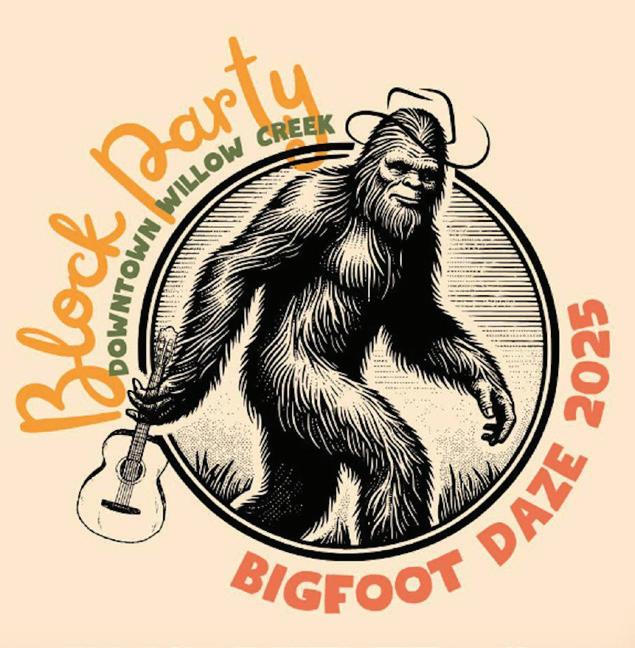
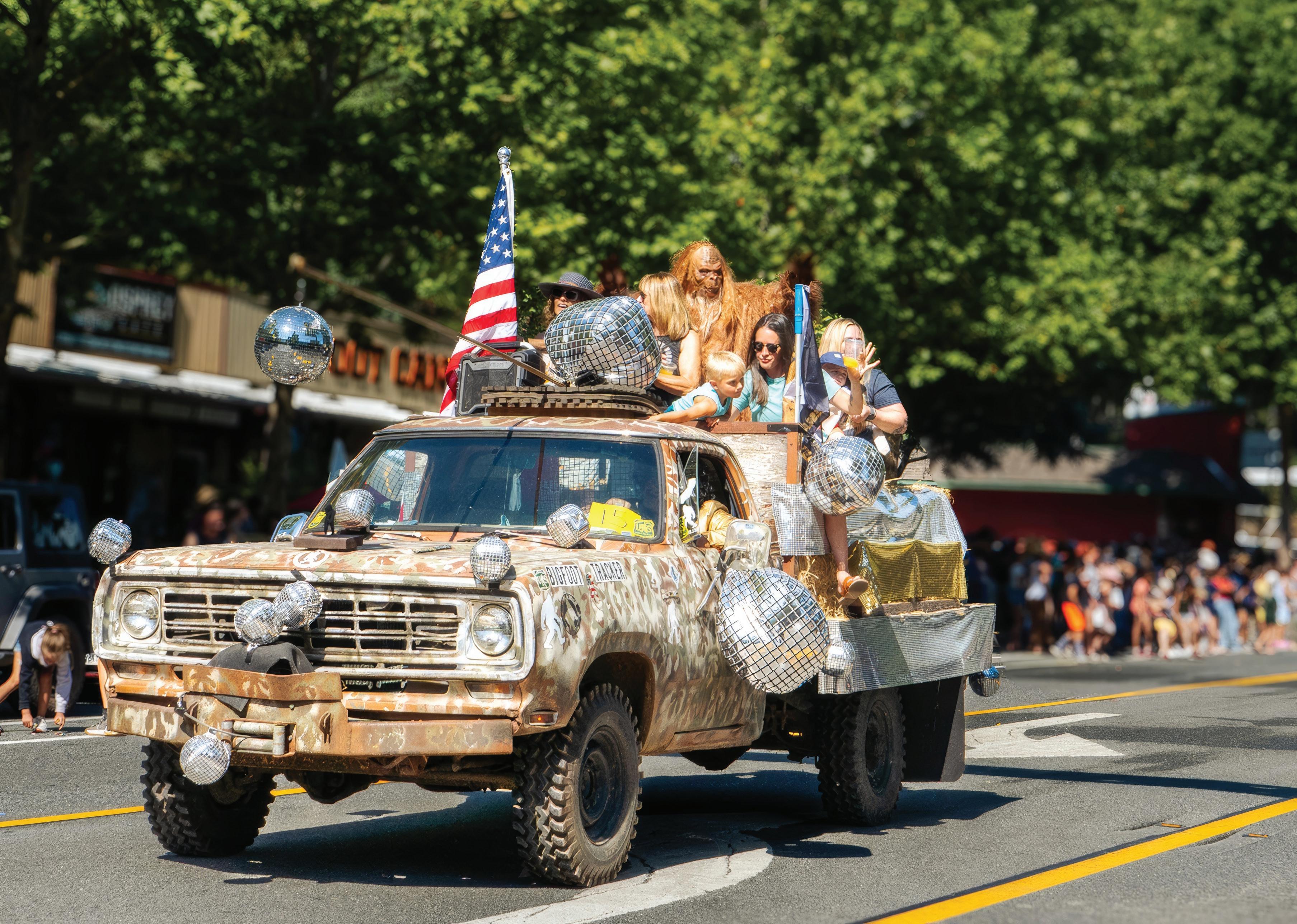
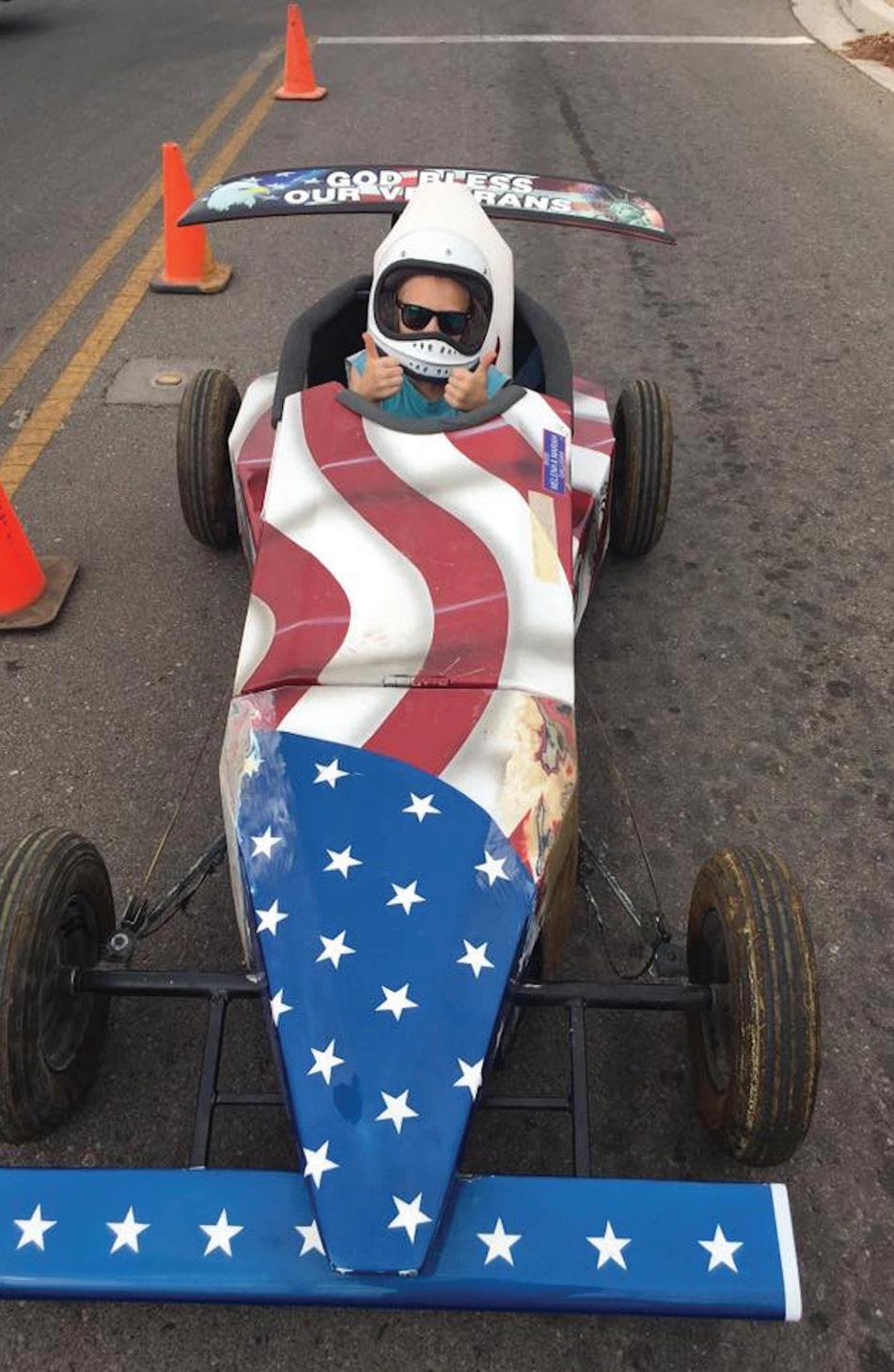
1 2 3 4 5 6
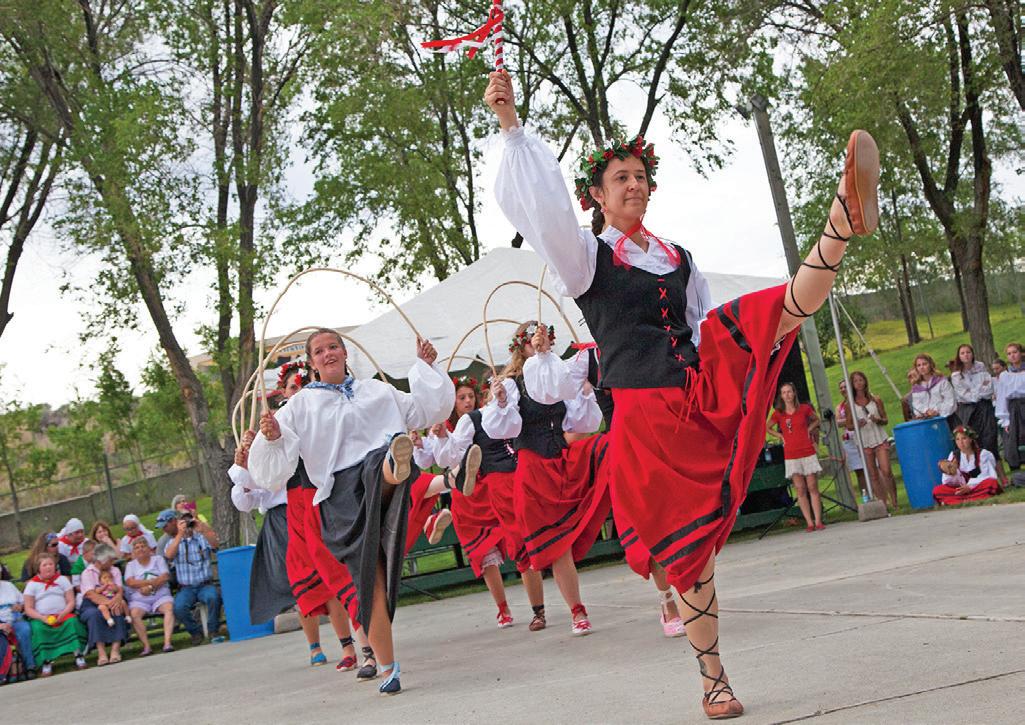
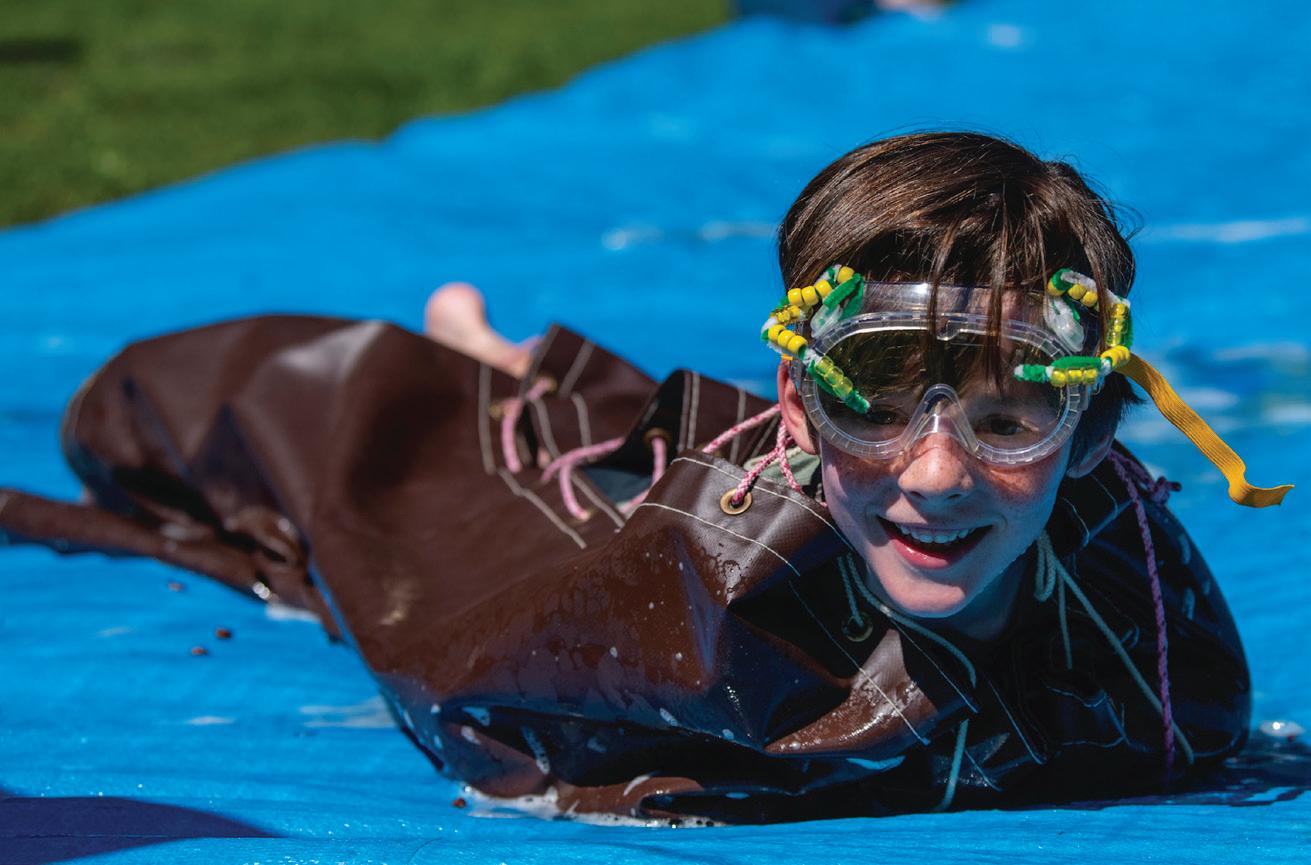
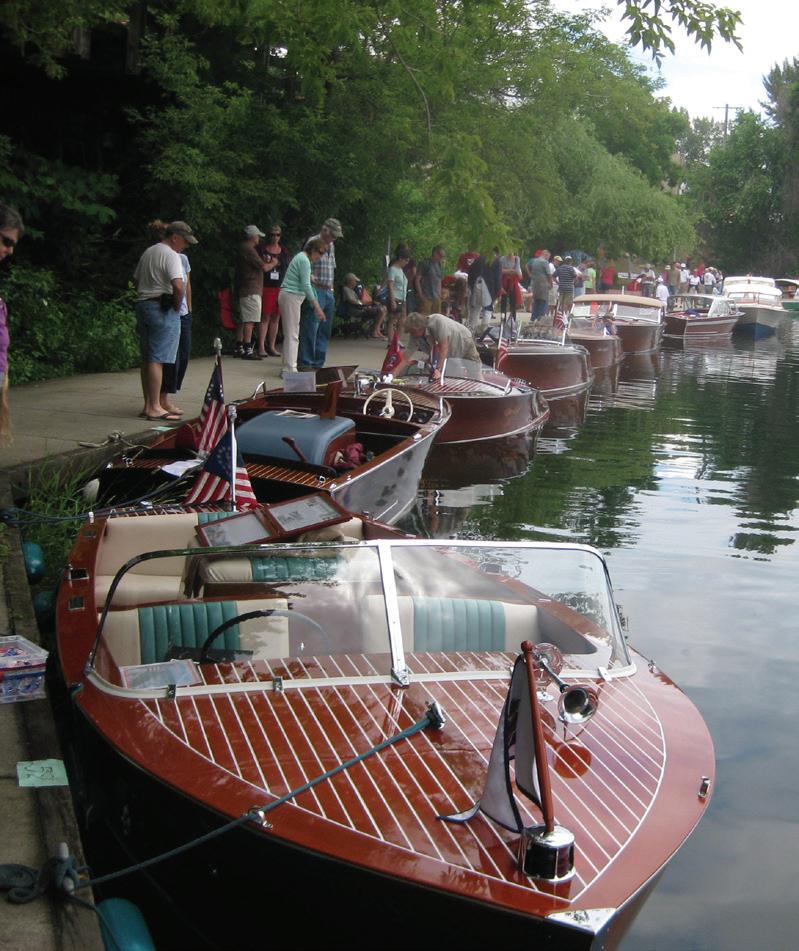
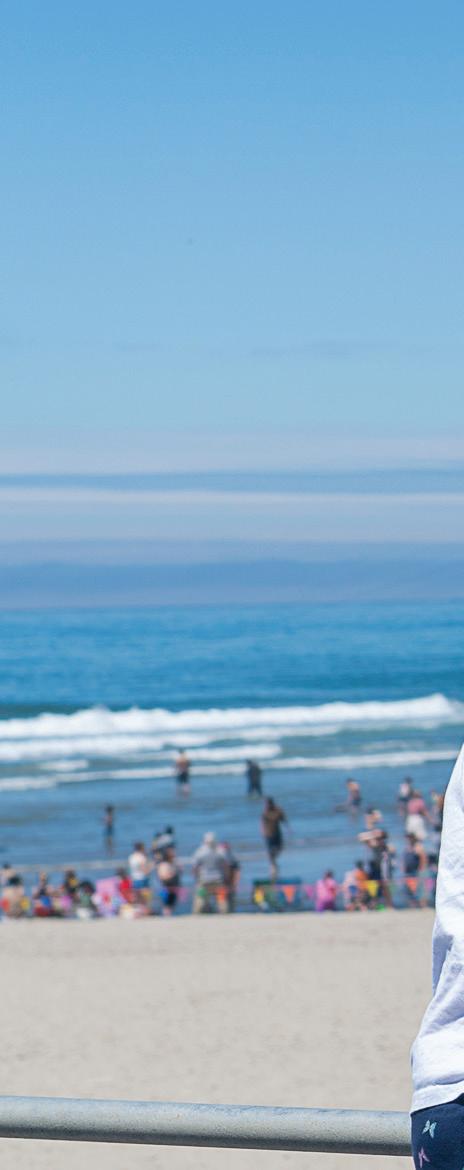
with a little garlic, sour cream and vinegar.”
Elko’s Basque restaurant, The Star, honors Basque culture year-round.
“People sit at the same long tables, and the food is served family style,” Michelle says.
The schedule of festival events will be posted on the Elko Euzkaldunak Club's Facebook page.
For more than a century, generations of Bisbee residents have celebrated the Fourth of July by racing soapbox derby-style cars, called coasters, at speeds of up to 40 mph down a canyon road.
“We start at the top of Tombstone Canyon and end at the post office,” says Bridgette Christian, chairperson of the Coaster Race Committee. “It’s how we start the holiday in the morning. My dad was a big volunteer, so I want to keep it going.”
Drivers ages 9 to 16 build their own vehicles and coast along for about 1.6 miles in roughly 3 minutes. They practice at trial runs in June to be ready for the big day in July.
The town’s population of 5,000 doubles during the event “because it’s so familyoriented,” Bridgette says. “We have a strong
sense of community here. We’re grateful to all the volunteers who make it happen.”
After the town’s copper mine closed, a large group of residents left the area, but many come back for a reunion to celebrate the summer holiday.
Other unique festivals in Arizona include the Oatman Egg Fry, ShoLo Lawn Mower Races and Wyatt Earp Days.
Bigfoot’s sonorous calls resound across the small town of Willow Creek in Northern California during Bigfoot Daze, the second Saturday of July.
“We have so many events with one of our most popular ones being the Bigfoot Calling Contest,” says Shannon Hughes, president of the Willow Creek Chamber of Commerce. “It always draws a lot of entrants and a lot of laughs, too.”
She says local and worldwide Sasquatch devotees come to the annual event.
“This will be our 63rd celebration,” she says. “For some, it’s an annual pilgrimage. It’s understandable why we’re the Bigfoot Capital of the World. We’re surrounded by wilderness where there are always some sightings.”
About 300 purported sightings of the elusive creature are chronicled at the local museum along with Sasquatch exhibits. A 1967 film taken near Bluff Creek became famous when it showed an ape-like creature walking along the banks.
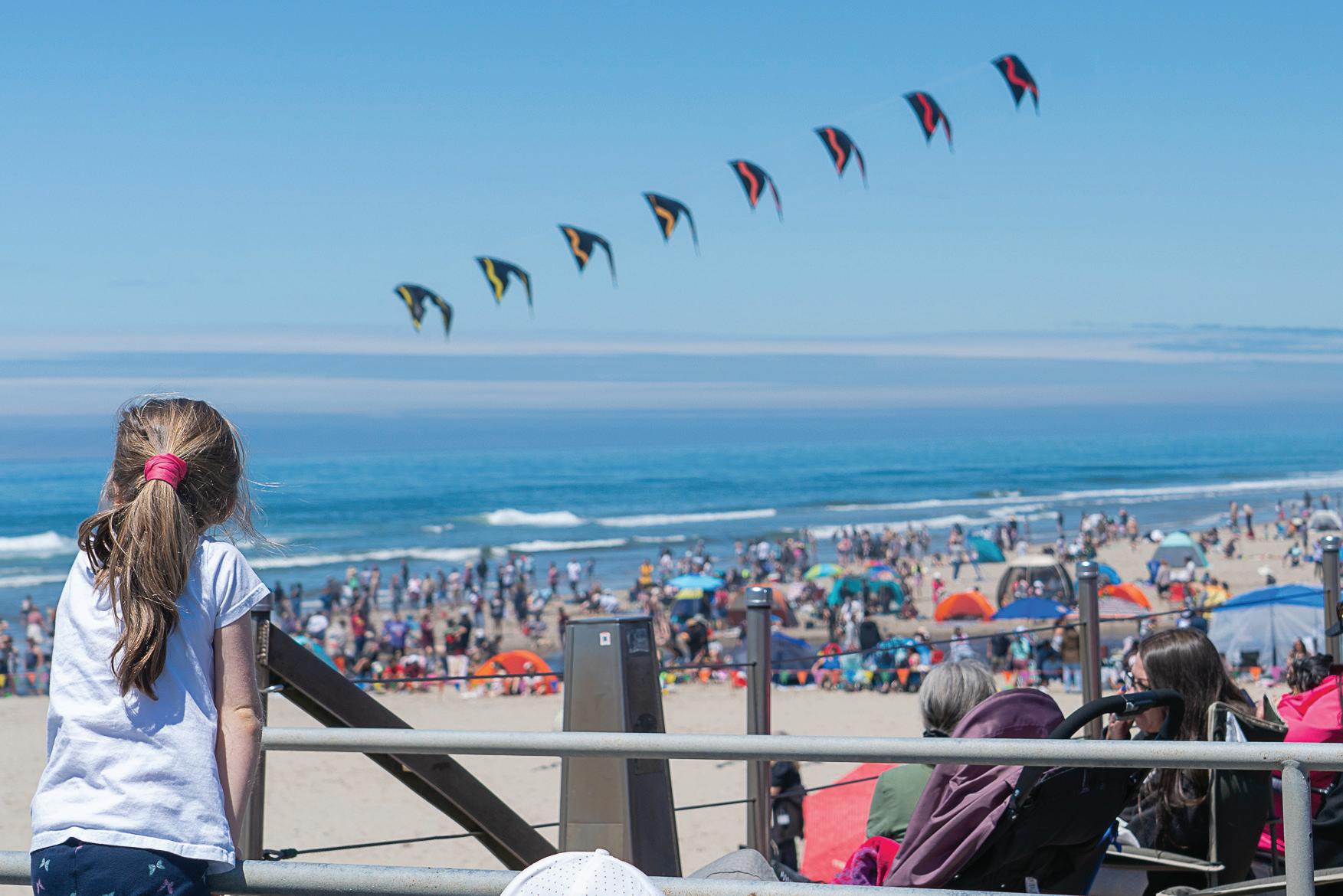
Among the numerous events, another one that makes spectators laugh is the 20-minute parade with entries expressing the theme of Bigfoot and the watermeloneating contest.
“It’s a great community festival,” Shannon says.
“May the slime be with you” is the saying on June 28-29 at Northwest Trek Wildlife Park in Eatonville.
Children learn what life looks like from a slug’s point of view. They even get the chance to race while wearing tentacle headbands, goggles and plastic sacks as they slide around on their bellies on a wet tarp.
The event is organized to celebrate the importance of the local yellow-green banana slug that helps decompose organic matter to nourish trees and plants.
Professional kite flyers demonstrate aerial acrobatics at Lincoln City Summer and Fall Kite Festivals in Oregon's Central Coast.
“It’s amazing what the professional flyers can do,” says Stephanie Hull, event outreach coordinator for Lincoln City. “We have about 50 flyers come to our events.”
KiteLife magazine named the town the Kite Capital of the World with its more than 7 miles of beach. Many festival participants handcraft their kites with shapes of whales or octopuses.
“The large inflatables are really creative,” Stephanie says. “Some people paint their own designs on the kites and others handsew them. Some choreograph their flights, too.”
This year is special.
“We’re celebrating our 40th summer festival and 45th fall festival,” she says. “We’re looking forward to seeing an LED illuminated night flight on Friday.”
The summer festival is June 21-22, and the fall festival is Sept. 20-21. n
4. Slugs are celebrated at a festival at the Northwest Trek Park in Eatonville, Washington, with festive events for children.
5. Boats align the boardwalk for festivalgoers to admire at the annual Silver Wake Celebration in Sandpoint, Idaho. 6. Professional kite flyers entertain beachside audiences at summer and fall festivals in Lincoln City, Oregon.
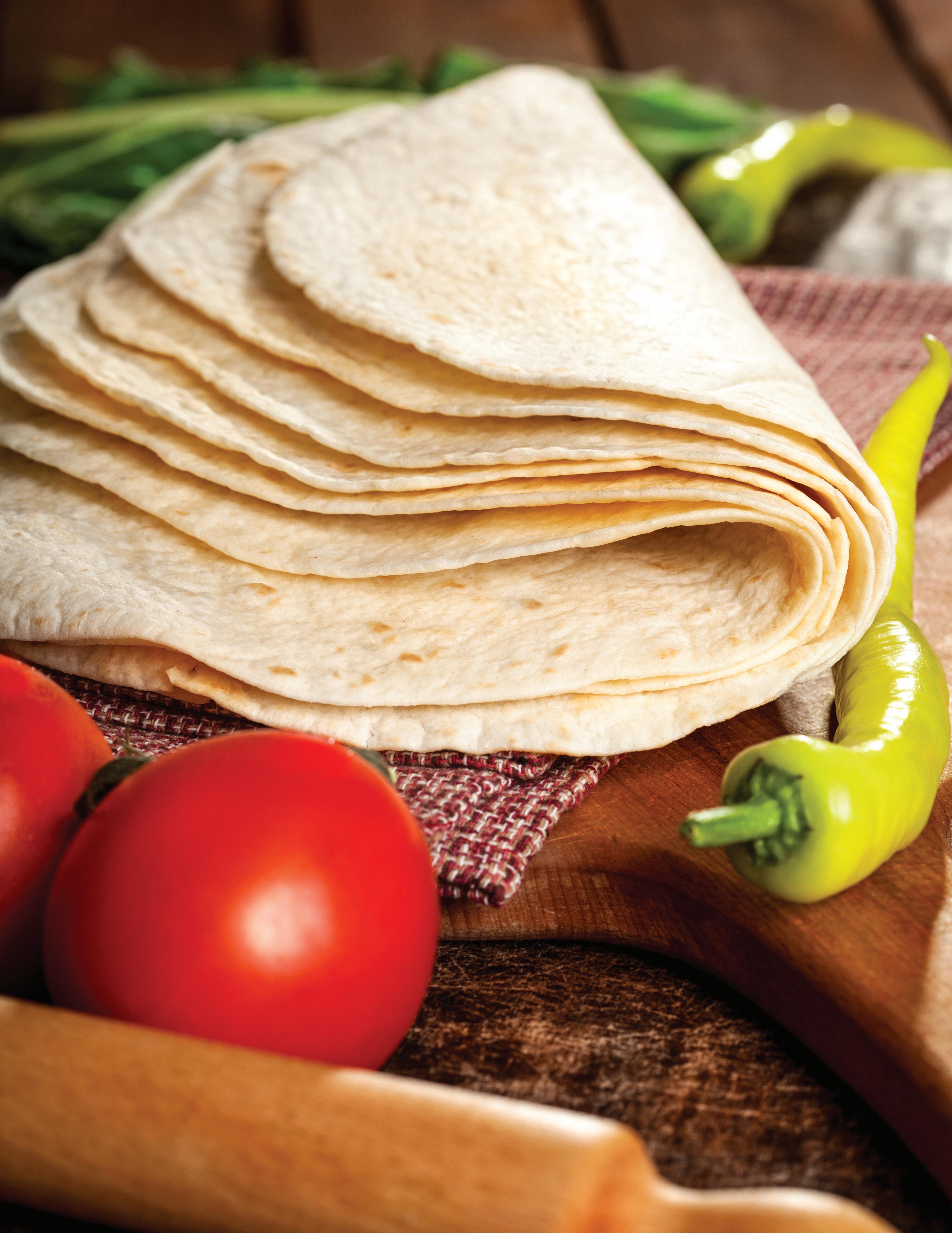
Easy Pepperoni Pizza Quesadillas
2 8-inch flour tortillas
2 tablespoons tomato sauce (may substitute spaghetti, pizza or marinara sauce)
10 to 12 slices pepperoni
6 to 8 tablespoons shredded mozzarella cheese
Butter
Additional tomato sauce
Spread tomato sauce evenly over entire tortilla in a thin layer. Add pepperoni, covering half of each tortilla.
Sprinkle the pepperoni with a layer of cheese. Fold over the top of the tortilla. Melt a bit of butter in a skillet. Place two quesadillas in the skillet. Cook 2 to 3 minutes over medium heat until lightly browned.
While the first side of the quesadilla is cooking, lightly butter the other side of each tortilla. Flip over the tortillas, and cook until the second side is browned. Remove the quesadillas from the pan. Let rest for a few minutes, then slice each tortilla into quarters or thirds. Serve with warm tomato sauce for dipping.
8 ounces cream cheese, softened
½ cup sour cream
1/4 cup picante sauce
2 tablespoons taco seasoning
Dash garlic powder
4.5-ounce can chopped olives, drained
4-ounce can chopped green chiles
1 cup finely shredded cheddar cheese
½ cup thinly sliced green onions
8 10-inch flour tortillas, warmed Salsa
In a small bowl, beat together cream cheese, sour cream, picante sauce, taco seasoning and garlic powder until smooth. Stir in olives, chiles, cheese and onions. Spread about 1/2 cup on each tortilla. Roll up jelly-roll style.
Cover. Refrigerate for at least 2 hours. Slice into 1-inch pieces before serving with salsa.
Taco Lasagna Recipe
2 tablespoons olive oil, divided
1 pound lean ground beef
1 medium yellow onion, diced
1 medium red bell pepper, cored, seeded and diced
2 cloves garlic, minced
15-ounce can black beans, drained and rinsed
1 tablespoon chili powder
2 teaspoons ground cumin
1 teaspoon dried oregano
1 teaspoon kosher salt
1/4 teaspoon freshly ground black pepper
16-ounce jar salsa, divided
12 8-inch corn or flour tortillas, divided
16 ounces sour cream, divided
16 ounces shredded Mexican cheese blend, divided
Heat oven to 350 F. Arrange a rack in the middle of the oven. Heat 1 tablespoon of oil in a large, high-sided skillet over medium-high heat until shimmering. Add ground beef. Cook, breaking up the meat with a wooden spoon, until browned and cooked through, 6 to 8 minutes. Using a slotted spoon, transfer the meat to a plate. Pour off any fat from the skillet.
Reduce heat to medium. Add the remaining olive oil. Heat until shimmering. Add the onion, bell pepper and garlic. Cook, stirring occasionally, until softened, about 5 minutes. Return the beef and any juices to the skillet. Add black beans, and stir to combine. Add chili powder, cumin, oregano, salt and black pepper. Stir to combine. Cook for 2 minutes.
Remove the skillet from the heat. Pour 1/4 cup salsa into a 9-by-13 baking dish. Pour the remaining salsa into the skillet. Stir to combine.
To assemble the lasagna, spread out the salsa in the baking dish into a thin layer. Arrange four tortillas in a single layer on top of the salsa, overlapping them as needed. Dollop and spread 2/3 cup of the sour cream. Spoon half of the meat mixture over the sour cream. Spread in an even layer. Sprinkle with 11/3 cups of cheese.
Repeat layering the following: four tortillas, 2/3 cup sour cream, the remaining meat mixture and 11/3 cups shredded cheese. Top with the remaining four tortillas and 2/3 cup sour cream. Sprinkle with the remaining 11/3 cups cheese. Bake, uncovered, until the cheese is melted and lightly browned, about 30 minutes. Cool for 15 minutes before serving.
Sour Cream
3 tablespoons butter
3 tablespoons all-purpose flour
2 cups chicken broth
1½ teaspoons chili powder
1/4 teaspoon oregano
¾ teaspoon salt
1/4 teaspoon black pepper
1 pound boneless, skinless chicken breasts, diced
1 cup sour cream
6 to 7 regular-sized flour tortillas, cut into bitesized pieces
7.5 ounces black beans, drained
14.5-ounce can diced tomatoes, drained
1 cup shredded cheese
In a large skillet, heat butter until melted. Stir in flour, and cook for 1 minute. Whisk in chicken broth. Stir until sauce is smooth and thickened, about 2 to 3 minutes. Stir chili powder, oregano, salt and pepper into the sauce.
Add chicken breasts to the pan. Bring to a simmer, then reduce heat to low. Cover and cook for about 15 minutes, until chicken is cooked through. Remove chicken from the pan, and shred into bite-sized pieces.
Stir sour cream into the sauce. Return the chicken to the skillet. Add tortilla pieces, black beans and tomatoes. Stir until combined, then top with shredded cheese.
Cover skillet and cook until bubbly and the cheese is melted, about 5 to 8 minutes.
11/4 pounds lean ground beef
1/4 cup finely chopped onion
11/4 cups salsa
2 tablespoons taco seasoning
½ cup water
2 15-ounce cans pinto beans, rinsed and drained
2 cups shredded cheddar cheese
12 8-inch flour tortillas, warmed
In a large skillet, cook beef and onion over medium heat until meat is no longer pink, about 5 to 7 minutes, breaking meat into crumbles. Drain. Stir in salsa and taco seasoning. Bring to a boil. Reduce heat. Simmer, uncovered, for 2 to 3 minutes. Transfer to a large bowl, then set aside.
In a food processor, combine water and beans. Cover. Process until almost smooth. Add to beef, and stir in cheese. Spoon 1/2 cup beef mixture down the center of each tortilla. Fold ends and sides over filling. Roll up. Wrap each burrito in waxed paper and foil. Freeze for up to 1 month.
To heat frozen burritos: Remove foil and waxed paper. Place one burrito on a microwave-safe plate. Microwave on high until a thermometer reads 165 F, about 3 minutes, turning burrito over once. Let stand for 20 seconds.
Searching for Louis L’Amour 1st print edition paperbacks only. Please respond with titles. I can pay fair price and shipping if requested. Thanks.
J Hall
P.O. Box 1456 Orofino, ID 83544 jwhall13@gmail.com
I’m retired and had double hip replacement in the past six months. I’m nearly recovered, and I started making patriotic American flags. They are roughly 30x20 inches tall. I’m requesting any type of fabric; printed with design or plain red, white, and blue that I can make into quilted American flags to sell.
Brian Cody 298 Basham Lane Troy, MT 59935
I’m looking for Scrabble tiles of all sizes. We are working on picture frames as a family project. Any contribution is appreciated.
Audra Shrauger
7999 SE Thomas Road Prineville, OR 97754
I’m traveling to Washington in early June to surprise my mom for her 90th birthday. Her name is Donna, and she is as spunky as ever. I would be grateful to take birthday cards to her from people all over the states. She was living in Fairbanks for a while, so if you know her ...shhhh... this is a surprise. Please mail to Lee Ann Hough, 1190 Pickering Drive, Fairbanks, AK 99709.
Lee Ann Hough Fairbanks, Alaska
My husband turns 75 this month. He has had some health issues, but is well now. We are trying to make this a great day. Please send to Bill Hoople, P.O. Box 81691, Fairbanks, AK 99708.
Janet Hoople Fairbanks, Alaska
Our mother is turning 90 this month. We would be thrilled for her to receive birthday greetings from friends and fellow readers across the country. She has a passion for photographing wildlife and the beautiful landscapes of Idaho. She’s still very active, enjoying her Bunco games, knitting, reading and sharing delightful tea with friends. Thank you so much in advance. Please send cards to Kay Deubel, 1717 Poplar St., Sandpoint, ID 83864
Brenda Sawyer Naples, Idaho
My mom is turning 100 at the beginning of June. She lived in Florence, Oregon, for her first 12 years, then in Eugene. She married in 1945 and was married for 55 years, living in Springfield all that time. Everyone always remembers her, as she has a beautiful smile. In her later years, she made crocheted clothes hangers for friends, family and whoever needed one. She was ecstatic to know I was making this request for birthday cards to be sent to her and will enjoy reading all of them. Thank you. Send to, Linda Snyder, 4001 SE 182nd Avenue, Apt #217, Gresham, OR 97030.
Barbara Toedtemeier Heppner, Oregon
I am searching for information, stories or pictures from anyone who has family history, stories or knowledge of the lost town of Cabinet, Idaho.
Craig Nelson 8760 River Road Clark Fork, ID 83811 Buscakccf623@gmail.com
A million thanks. Thank you so much to all the readers who sent my dear husband, Robert Dodge, warm wishes for his birthday. He was overwhelmed to see so many cards (more than 600). We are still reading through them. Many people sent small gifts, paintings and even a $2 bill. Many of the senders related to Bob’s service in the Marines, the Boy Scouts and hunter’s safety. There is no way we could send thank you notes to each person, so this will have to do. Our heartfelt thanks for all the wonderful people who care enough to send best wishes. Bob is forever grateful, as am I.
Carol Wennstrom Blachly, Oregon
Send your request—with no attachments—to readerexchange@ruralite.org or mail to Reader Exchange, 5625 NE Elam Young Parkway, Suite 100, Hillsboro, OR 97124. Fill in the subject line with Reader Exchange. Acceptance, scheduling and editing are at the editor’s discretion. Single requests only, please. No duplicates.
Submissions are handled on a first-come, first-served basis and as space allows. We cannot honor every request.
Please affirm you have authorization from all appropriate parties before submitting. By submitting, you indemnify Reader Exchange, Pioneer Utility Resources Inc., its officers, directors, employees, utility clients and insurers from all legal liability incurred by the publication of information.
We no longer accept pen pal requests. You may submit a pen pal request as a Marketplace ad. Marketplace pricing applies.
When submitting a milestone request, please send it at least two months before the milestone.
Phone numbers will not be published. Email addresses will be published if part of the ad, but the request must include a postal address.
Request must include the name and address of the electric utility that provides your magazine.
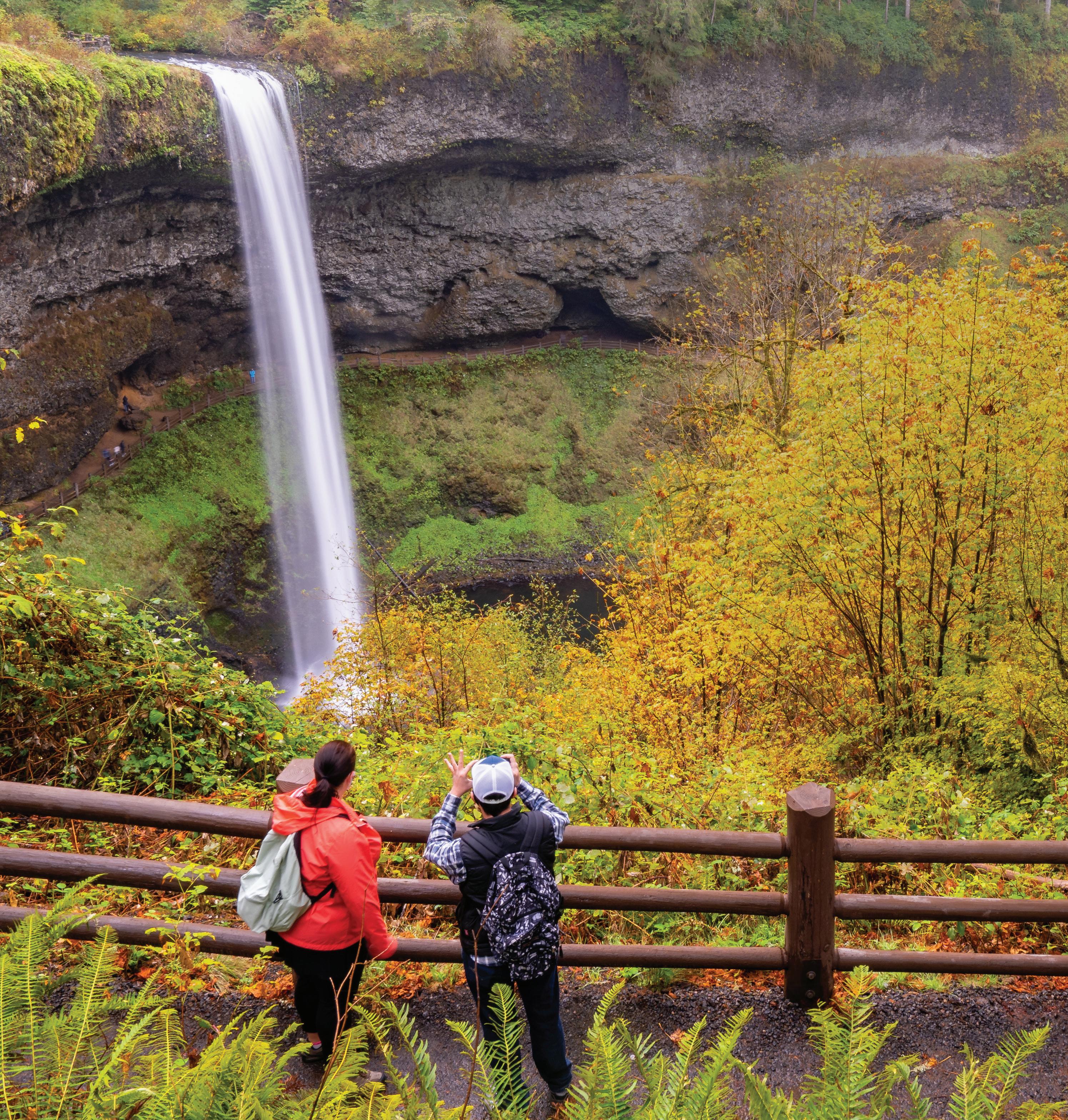
Hike into a rainforest to see a 177-foot waterfall at Silver Falls State Park in Oregon. First opened in 1933, the park is a magnet for hikers and bikers.
Oregon’s Largest State Park
Silver Falls State Park is less than an hour east of Oregon’s capital city, Salem, and contains 9,000 acres. Many of the park’s original trails, walls and buildings were built in the 1930s by the Civilian Conservation Corps.
The park is known for its more than 35 miles of trails, with the Trail of Ten Falls as a highlight. The 7.2-mile loop is classified as a moderate hike, with 800 feet of elevation change. The trail gives great views of the park’s waterfalls and winds behind four of them, providing a unique angle of the falls.
A few years ago, the park opened the North Rim Trail, which gives a more accessible way to see the North Falls. Beginning from the new North Canyon Trailhead, the 1-mile trail has a compacted surface 6 feet wide. The new North Canyon day use areas also have picnic tables, restrooms and access to the park’s Nature Play Area.
More Information
Silver Falls State Park is open every day of the year. Hours vary according to the season. Parking is $5 per day. To start planning your visit, head to friendsofsilverfalls.net.
Sealed Vault Bags full of State Silver Bars are actually being handed over to the first U.S. residents who find their zip code listed in today’s publication and call before the 21 day order deadline ends to claim the bags full of pure silver
NATIONWIDE - Operators at the National Silver Hotline are struggling to keep up with all the calls.
That’s because Silver Vault Bags loaded with pure .999 State Silver Bars are now being handed over to everyone who beats the order deadline.
“That’s why U.S. residents will be hoarding all the silver bars they can get their hands on before the deadline ends. This comes as no surprise after the standard State Minimum set by the Lincoln Treasury was dropped for everyone who gets the Silver Vault Bags making them a real steal,” said Mary Ellen Withrow, the Fmr. 40th Treasurer of the United States of America, Emeritus.
“As executive advisor to the private Lincoln Treasury, I get paid to deliver breaking news. And here’s the best part. This is great news for U.S. residents because the reduced State Minimum set by the Lincoln Treasury is a real steal,” said Withrow.
The only thing residents need to do is find the first 2 digits of their zip code on the Distribution List printed in today’s publication. If their zip code is on the list, they just need to call the National Silver Hotline before the deadline ends.
And here’s the good news. Residents who do are getting the reduced State Minimum set by the Lincoln Treasury of just $390 for each State Silver Vault Bag which is just $39 for each pristine Silver half ounce bar as long as they call the National Silver Hotline at 1-888-415-6109 before the deadline ends.
Phone lines open at precisely 8:30 A.M. this morning and are expected to be flooded by U.S. residents looking to cash in on the reduced State Minimum set by the Lincoln
(Continued on next page)

■ U.S. RESIDENTS CASH IN: Calls are pouring in from state residents who are trying to get their hands on the Jumbo Silver Ballistic Bags pictured above before the deadline ends. That’s because residents who find the first two digits of their zip code printed in today’s publication are cashing in on the reduced State Minimum price set for the next 21 days by the Lincoln Treasury.
Who gets the Silver Vault Bags: Listed below are the zip codes that get to claim the Silver Vault Bags. If you find the first two digits of your zip code below immediately call: 1-888-415-6109 DEPT. SMB199
(Continued from previous page)
Treasury to date. That’s why U.S. resi dents who find their zip code on the distribution list today are being urged to call.
Since this special advertising announcement can’t stop anyone from buying up all the new 2025 Edition U.S. State Silver Bars they can get their hands on, the Lincoln Treasury has not set a limit of how many Jumbo Silver Ballistic Bags residents can get – these are the bags pictured that contain 10 individual Silver Vault Bags each. Everyone who gets these will be glad they did.
“Residents who want to cash in on the reduced State Minimum set by the private Lincoln Treasury better hurry. That’s because after the deadline ends, the State Minimum for these pristine half ounce U.S. State Silver Bars set by the Lincoln Treasury will go up to $68 per bar no matter how many bars people get,” Withrow said.
“We’re bracing for all the calls and doing the best we can, but with just hours left before the deadline ends, residents who find the first 2 digits of their zip code listed in today’s publication need to call the National Silver Hotline,” Withrow said.
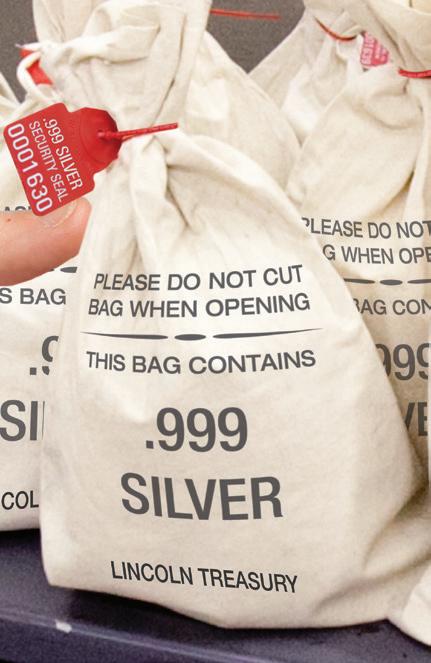
■ SILVER IS SOARING: It’s good news for state residents who get the Silver Vault Bags each loaded with 10 solid .999 pure Silver State Bars. That’s because residents are getting the State Minimum set by the private Lincoln Treasury as long as they call before the deadline ends.
I keep calling and can’t get through: Keep trying. Right now everyone’s looking to cash in on the reduced State Minimum set by the Lincoln Treasury. In fact, we won’t be surprised if thousands of residents order up as many Silver Vault Bags as they can get their hands on before the deadline ends. That’s because the State Minimum set by the Lincoln Treasury has been reduced to just $39 for each silver half ounce bar for everyone who gets the vault bags. And since each Silver Vault Bag contains 10 pristine State Silver Bars for just $390 we’re guessing state residents will be claiming two or more bags while they’re up for grabs. But all those who really want to cash in are taking the Jumbo Silver Ballistic Bags containing 100 State Silver Bars before the deadline ends and the State Minimum set by the Lincoln Treasury goes up to $680 per Vault Bag. In fact the State Minimum set by the Lincoln Treasury is reduced even further for those getting the Jumbo Bags so just be sure to ask the National Silver Hotline operator for your discount. So if lines are busy keep trying.
How much are the Silver Vault Bags worth: It’s hard to tell how much these Silver Vault Bags could be worth since they are in pristine condition, but those who get in on this now will be glad they did. That’s because the State Minimum set by the Lincoln Treasury goes up to $680 per bag after the deadline ends. So you better believe that at just $390 the Silver Vault bags are a real steal for everyone who beats the deadline.
Can I buy one State Silver Bar: Yes. But, the reduced State Minimum set by the Lincoln Treasury of just $39 per bar applies only to residents who purchase a Silver Vault Bag(s). That means only those residents who order a Silver Vault Bag(s) or a Jumbo Silver Ballistic Bag get the reduced State Minimum set by the Lincoln Treasury. All single bar purchases, orders placed after the deadline and all non-state residents must pay the normal state minimum of $68 per silver half ounce bar.
Why is the State Minimum set by the Lincoln Treasury so low now: Thousands of U.S. residents stand to miss the deadline to get the silver at the reduced State Minimum set by the private Lincoln Treasury. Now all residents who find their zip code on the Distribution List to the left are getting the Silver Vault Bags for themselves and all the solid .999 pure State Silver Bars found inside. The price for each Silver Vault Bag after the deadline ends is set to the normal state minimum of $680 which is $68 per bar. But residents who beat the 21-day deadline only cover the reduced State Minimum set by the Lincoln Treasury of just $390 for each State Silver Bar Bag which is just $39 per bar as long as they call the National Silver Hotline before the deadline ends at: 1-888-415-6109 DEPT. SMB199. Hotlines open at 8:30 A.M.
*** All 7 States listed are available - States not listed are already sold out ***

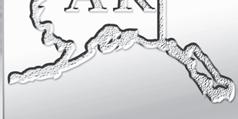

WEIGHTS AND MEASURES FULL-HALF TROY OUNCE SOLID .999 FINE SILVER
















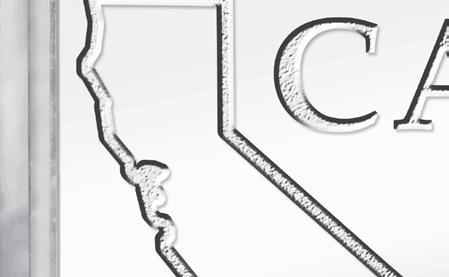





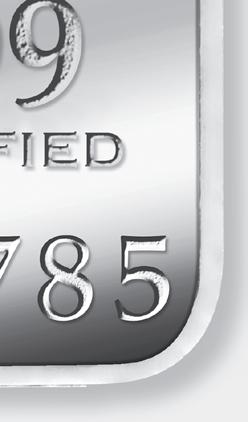
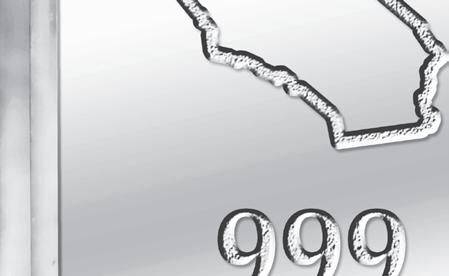




DATE NUMBERED IN WHICH THE STATE RATIFIED THE CONSTITUTION AND WAS ADMITTED INTO UNION
CERTIFIED SOLID SILVER PRECIOUS METAL BACK
ALL 7 STATES LISTED ARE AVAILABLE.
By Dave LaBelle
There are annual events—such as birthdays, anniversaries and holidays—many of us are determined to make pictures of.
One of the annual events I am often called on to photograph is fireworks during the Fourth of July. Here is where I confess, even though I have photographed fireworks for more than a half a century, I never seem to capture the picture I want.
Oh, I have made some acceptable pictures through the years but not one that I felt expressed what I saw and felt.
I surveyed the grounds early where the fireworks were to be launched this past year, seeking every possible angle.
Some cities have hilltops or big rivers running through them, like Pittsburgh or Portland, Oregon. But Dyersville, Iowa, is flat with few bumps we might dare to call hills.
Finally, I decided on a low, grassy spot that afforded a relatively clean, uncluttered view of the aerial bursts. However, as parking spaces grew thin, vehicles lunged forward, parking on the grassy spot I had
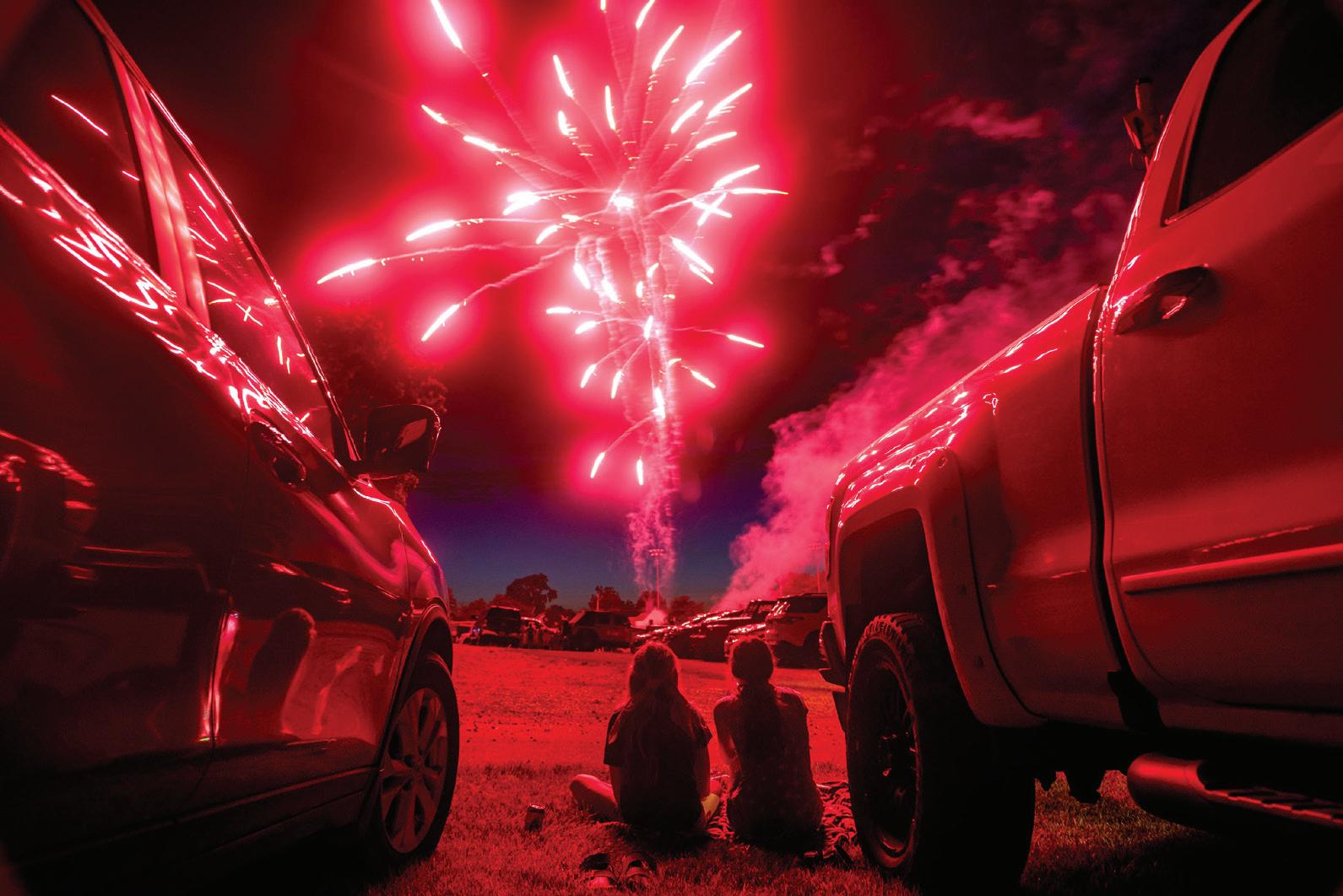
chosen. Camera and tripod in hand, I had to move or get run over.
Just as I was about to seek another last-minute vantage point, a couple of children put down a blanket between two vehicles and sat waiting for the show.
Hmmm?
If I could get low enough, they might make a good foreground, their shapes against
a lit-up sky.
I moved up slowly and stealthily behind them and lay on the ground to see if I could get the camera low enough— off the tripod—to see if I had enough sky to see and capture fireworks once they began.
At one point—still 30 minutes before the show—I had to explain to their father, watching me suspiciously, the photo I was hoping to capture.
Determine to make a beautiful photograph that captures the spirit of celebration meant by filling the sky with beautiful explosions of color and design. Scout areas and choose the spot first. Then consider using a tripod and slower shutter speed. To create depth and context, foreground is key. Above all, experiment with exposure. Each burst is often a different color and intensity.
Email your best image (just one) with caption information, including an explanation of how it affects you, to gph@pioneer.coop. We may share submissions on our website and social media channels.
As most of you who have attempted to photograph fireworks know, there is a lot of luck involved. That acknowledged, the old maxim, “Luck is where opportunity meets preparation,” was on my side this evening.
After a handful of lowbursting blasts, finally a reddishpink explosion filled the sky low enough to wash over and even reflect on the parked vehicles. n
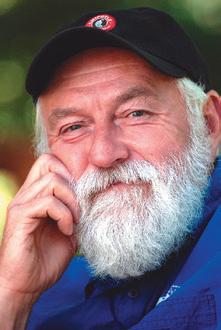

It is time to share your favorite photos for a chance to appear in our 2026 Ruralite calendar. Up to 13 winners will be selected and receive $100. Photos must be submitted by June 30, 2025. The contest is open to recipients of Ruralite and Currents magazines. Each person may only submit up to two photos. Each submission must include:
• Photographer’s name, address and electric utility.
• A short description of what is shown.
• Photographer’s email address and phone number.
• JPEG file photos only. Photos must be horizontal or landscape format and at least 300 dpi at 11 inches wide by 9 inches tall. Vertical photos and files larger than 30 MB will not be accepted. Enter today by visiting tinyurl.com/ruralitecalendar or use the provided QR code on this page.
Winning Tips
• Use the highest resolution setting on your camera.
• Photograph beautiful places and wildlife.
• Capture scenes full of vivid color.
• Reflect the seasons.
• Make us feel something—awe, joy, etc.
For more information, visit ruralite.com/2026contest.
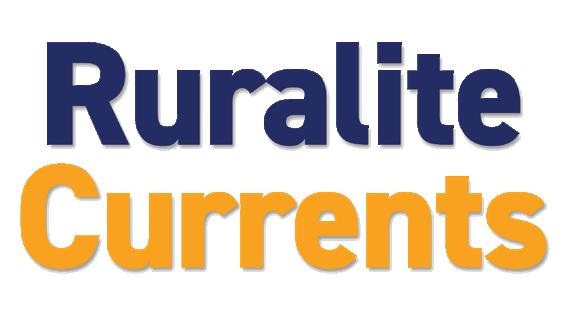
With more than 200 recipes, this cookbook offers many options for potlucks, family reunions or picnics planned this summer! An added bonus in the back are the recipes from a previous barbecue recipe contest. “Perfect for a Potluck” is an 8½-by-11-inch indexed cookbook for only $10, which includes postage.
To order by mail:
Submit proper payment with your name, address and the number of cookbooks wanted to Ruralite Cookbooks, P.O. Box 1306, North Plains, OR 97133.
To order by phone:
Call 503-357-2105 to pay with VISA, MasterCard, Discover card or American Express.
To order online: Visit www.ruralite.org.
Please allow 2-3 weeks for delivery.





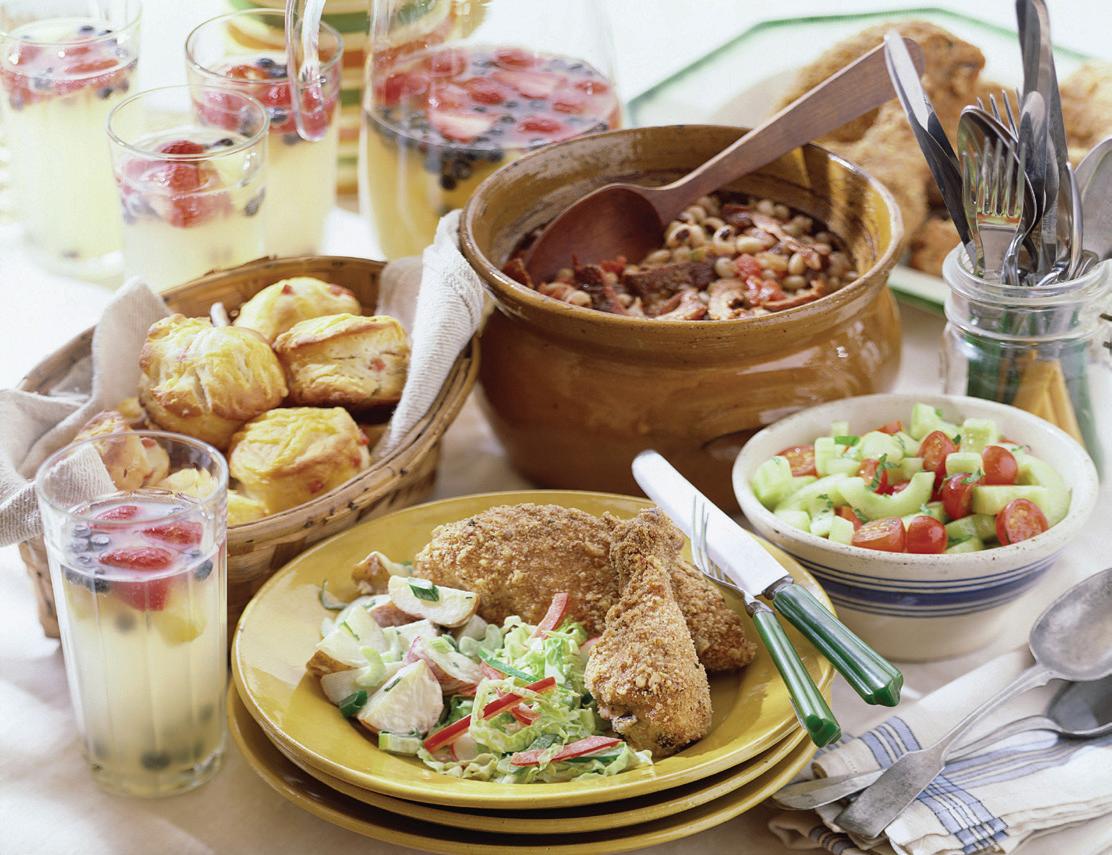

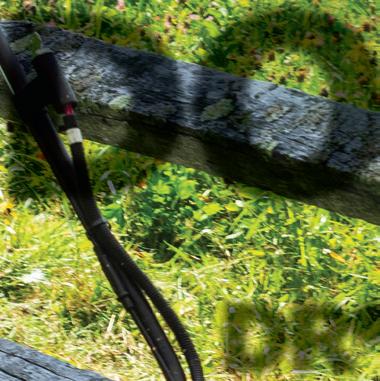




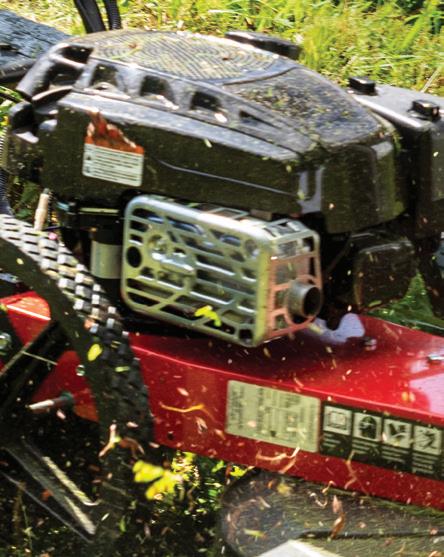
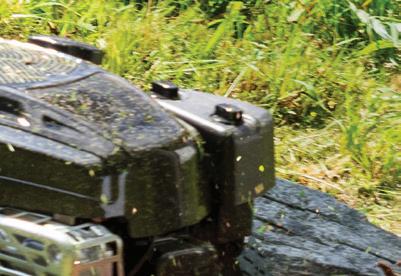

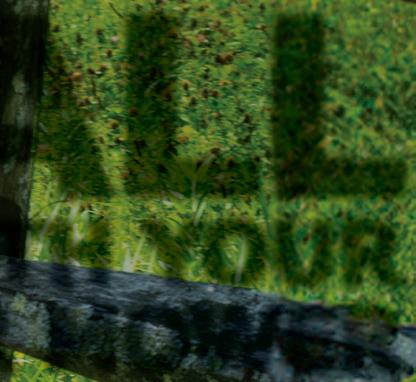
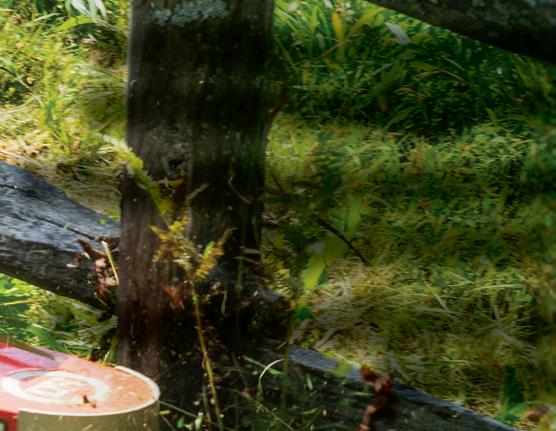

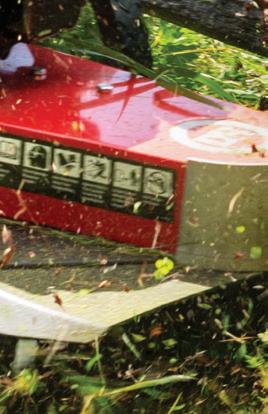






































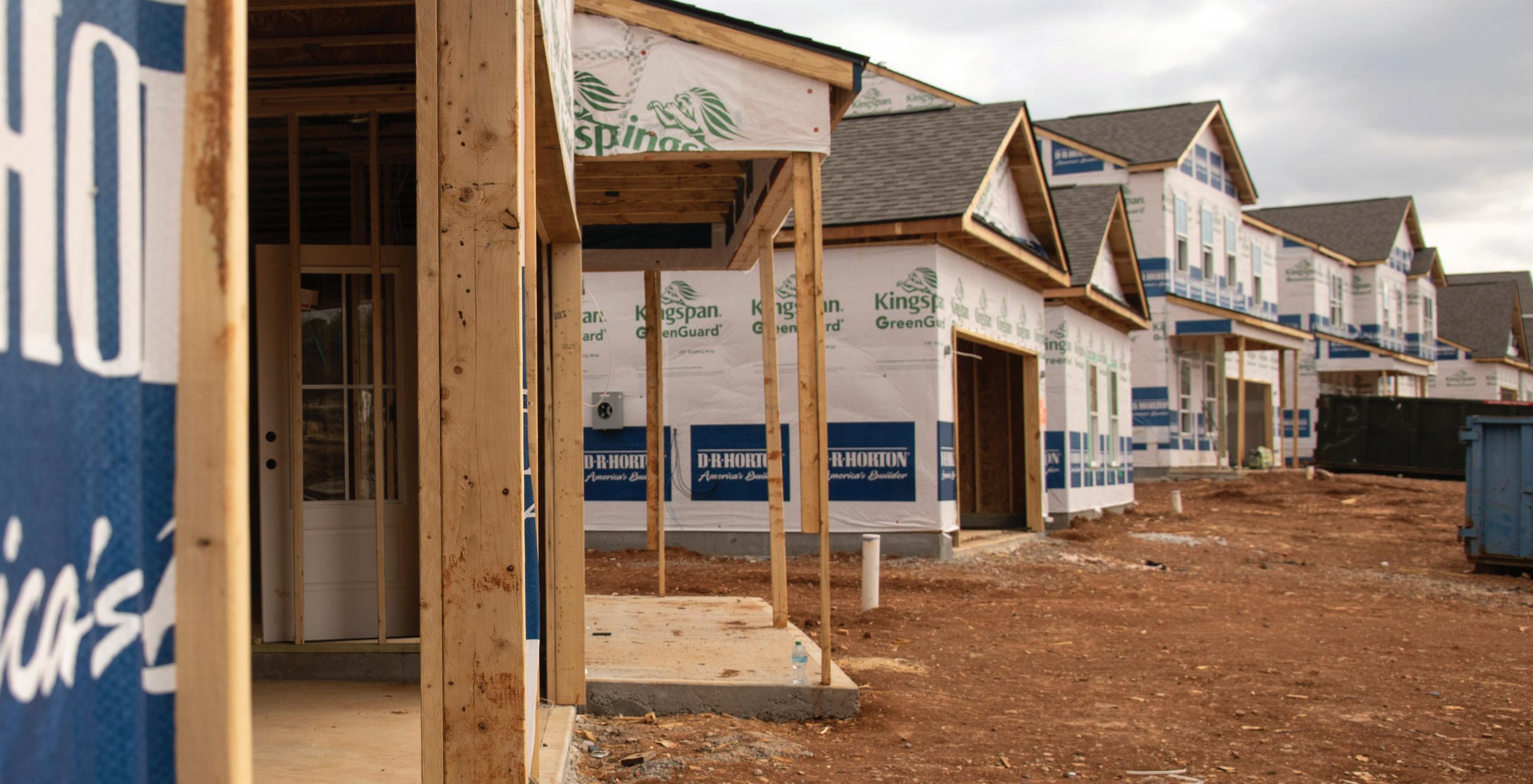
By Miranda Boutelle
Q: What are some energy-efficiency upgrades I should consider when building a new house?
A: Prioritizing energy efficiency when building a new home can create future savings and make living more comfortable. It might cost a little more upfront but will pay off in the long run.
Let’s explore two approaches: Following an energy-efficiency certification plan or adding energy-efficient design and equipment to your construction project.
There are several energy-efficiency certifications available for newly constructed homes that may qualify for discounted homeowner’s insurance, tax credits and other incentives.
Leadership in Energy and Environmental Design certification ensures the home uses less energy while prioritizing sustainable resources and healthy indoor air quality. LEED-certified homes use 20%-30% less energy than the average home—with some homes saving up to 60%—and can cost the same as non-LEED homes with proper planning, according to the U.S. Green Building Council.
Passive House certification requires the home to be so efficient it needs little to no heating and cooling equipment while remaining comfortable for its occupants. To achieve up to 90% less energy use than the average home, the certification focuses on maximizing the efficiency of the building envelope—all components that separate the indoors from the outdoors—including proper insulation levels, air sealing and high-efficiency windows.
Energy Star NextGen Certification for New Homes recognizes houses that are 20% more efficient than the average home and help reduce greenhouse gas emissions by 40%-80%.
Although various certifications are available, you don’t have to follow a set guide. Consider adding these energy-efficiency principles to your new home build.
Advanced framing techniques maximize the amount of insulated area and save on material costs in wood-framed homes. This
technique can save on material costs—up to $500 for a 1,200-squarefoot home and $1,000 for a 2,400-square-foot home. It can also save 3%-5% on labor costs and up to 5% on annual heating and cooling costs, according to the U.S. Department of Energy. Choose a contractor who is familiar with these techniques, and check with your local building officials to ensure compliance with local codes.
The importance of a home’s orientation is often overlooked. According to the International Association of Certified Home Inspectors, homes oriented toward the path of the sun use less energy for heating and cooling to reduce energy bills and improve comfort.
If you are building or buying a new home that doesn’t allow options for orientation or framing, you might be able to request higher insulation levels in the attic. Increasing the insulation levels likely won’t cost much more for materials and labor, but it can help you use less energy and save money in the long run.
Heating and cooling equipment should be properly sized using energy modeling tools that calculate the home’s heating and cooling needs. Investing in a more efficient building envelope that is wellinsulated and air-sealed can reduce the home’s heating and cooling load, making it possible to have a less expensive heating and cooling system. This saves money on equipment costs and lowers energy use.
Optimizing the efficiency of a new home requires a whole-house approach. Analyze all systems and how they work together to ensure maximum efficiency for a safe and comfortable home. n
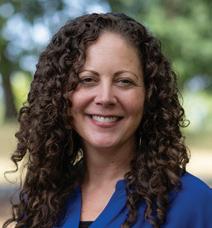
Agriculture
4x5 round bales, Meadow Foxtail Orchard Grass. 4x4 Timothy, small square. 208-435-4637 or 208-435-4002; nas@cpcinternet.com.
Reinforced custom-sized pond liners (39 cents/sqft). Hay covers, greenhouse covers, any width and length. Truck tarps and more. High puncture and tear strength. Best price guaranteed. Celebrating 44 years in business. www.btlliners.com. 541-447-0712. 0426
Antiques and Collectibles
Buying antiques and collectibles: advertising signs, porcelain signs, gas pumps, beer signs, antique toys, cast-iron coin banks, neon signs and more. Jason, 503-310-3321 or tjabaughman@yahoo.com. 0925
Buying American Indian collectibles: Navajo jewelry, blankets, rugs, CA/AZ baskets and beadwork. Quality paintings of the early Southwest and Americas. Call 760-409-3117 or send photos to amer.ind.baskets@gmail.com.
Assisted Living Facility
Haven House assisted living at Fossil, OR. It is a wonderful place to live. For more information, call Lou Gabica, 541-763-4651.
Automotive
Rare 1960 Chevy pickup 4x4. Short-bed. Not running now. Text or call 661-713-3377. Leave message. $7K. 0625
1966 Ford Mustang Coupe in good condition. Runs well. 289 automatic. 89K miles on rebuilt engine. Wimbledon white, much of car is original. $16K. Kathi, 541-419-3243.
2006 Mazda Miata. Blue. MX-5. Convertible. Only 70K miles. Custom exhaust. Excellent condition; ready to go. Always kept in garage. $10K cash. 541-661-1644. 0625
1960 GMC 4500. 21/2 FB. Many newer parts: windshield, master cylinder, clutch, radiator, wiring harness, transmission. $750. La Grande, OR. Brent, 541-805-4909. 0625
1929 Studebaker and 1956 Ford Courier. Call 541-786-5833. 0625
1970 Ford F-100. Rare truck 4x4. Short bed. Mint green, original pain. Sitting 6 years. Not running. $11K. Paul, 775-296-3604.
1978 Mirrorcraft. 14’ aluminum boat, trailer, 2 extra tires and wheels, 15hp craftsman outboard, oars, anchor, fuel tank, 2 seats. $1.25K. La Grande, OR. Brent, 541-805-4909.
Ads 25 words or fewer are $35 a month. An extended ad of up to 35 words is $50 a month. Contact information is included in the word count. Phone numbers and emails count as one word.
Longer ads may be placed. Contact 503-357-2105 or info@pioneer.coop for pricing information.
Ads are for customers of member co-ops, public utility districts and municipals only. Subscribers and nonmembers may inquire about pricing at 503-357-2105 or info@pioneer.coop.
Ads must be direct and in first person, and are subject to approval and editing.
Closing deadlines (in our office): July issue—June 2, 2025.
If submitting ad by mail, send appropriate payment with your name, address, email, phone number and the name of the electric utility that provides your magazine to: Marketplace, P.O. Box 1306, North Plains, OR 97133. Make check or money order payable to Ruralite.
We accept credit card payments for ads submitted by email. Send ad to info@pioneer.coop.
Call 503-357-2105 to pay by credit card.
Advertisements are accepted in good faith. Pioneer Utility Resources is not liable for interactions between buyers and sellers.
Books, Magazines, Videos
Book restoration. Bibles, cookbooks, cherished family heirlooms. Beautiful work. We give renewed life, more durable than original, to last for generations. 775-537-7066; salacanstudio@gmail.com. 0725
For Rent, Lease
Northeast, OR. 1 bd, 1 ba, bonus room. Nice smaller home. Water/sewer/garbage paid. On the river. $650 month, plus deposit. 55-plus preferred. Phone calls only, 541-519-3400. 0625
Quiet, spacious country home. Fully furnished, sits above Clearwater River near Lenore, ID. 3 bd, 3 ba. 1-month minimum. $1.9K. 208-476-7688.
Free materials—When church/government unite, enforcing Sunday Law, the “Mark” of the “Beast” is here. Don’t be deceived, be informed. Leave mailing address only, TBSM, P.O. Box 374, Ellijay, GA 30540. 888-211-1715; tbsmads@yahoo.com. 0625AR
Miscellaneous
2010 Artesian Swim Spa. 7x14’. Excellent condition. $12K. Pelican paddleboat, 5 passenger. Used twice. $500. 541-954-3884. 0625
Foster parents needed to care for teen youth in Wasco and Hood River counties. Agency provides on-call support, training, $2.1K/youth monthly reimbursement, 2 days off/month. Fosterinfo@nextdoorinc.org; 541-308-2207. 0625
Local commercial fisherman sells summer catch of preserved freshness by blast freezing at sea, gourmet canned tuna on internet. Sept.June. 100% guaranteed the best canned tuna you ever tasted. Original, jalapeno and garlic flavors available. To order: twofisherstuna.com or 206-799-1082. 0625
3 cemetery plots, Salt Creek Cemetery near Dallas, OR. $1.2K each. Open to offers on all. Message, 503-457-8084. 0625
Granite cemetery markers at affordable prices. Will ship to most places. Joe, 541-815-8906; highdesertmemorials@gmail.com or highdesertmemorials.com. 0625
Your ad could be here in July. See instructions above for details.
Pets
Fort Sage Kennels closing. AKC-registered Airedales. Females, 1 year old. Males, 2 to 3 years old. 530-827-2271, 530-249-7896. 0925
Border collie/McNab puppies. The best dog you will ever have. Males and females, $450 each. Colton, OR. 503-314-0145. 0625
Plants
Cactus for sale. Cold/winter hardy. Good for landscaping. Sunnyside/Mabton, WA, area. Local pickup only. 509-391-5546; marybarthlow@gmail.com. 0725
Cozy Dayville home with country charm and mountain views. $232.5K Duke Warner Realty, 541-987-2363, ddwr@ortelco.net. 0625
320 acres east of Adel, OR. Borders Hart Mountain views, Steens Mountain and Beaty Butte. Landowner tags, very rural. $179K. Quick sale due to injury. For maps: 541-659-1573; thejugglingman3@gmail.com. 0625
Granite, OR. 3 city lots, 3/4 acre each, one has an off-grid cabin. Year-round activities: hunting, fishing, hiking, skiing, snowmobiling, 4x4, etc. $200K for all 3. 541-519-9077; billpathanley@gmail.com. 0625
Irrigon, OR. 3-bd, 2-ba manufactured home on permanent foundation. Lawn maintenance business with equipment. Huge shop and garage stick-built, unattached. One full city block property. $435K. 541-922-9675. 0625
Let me help you buy or sell ranch, farm and recreation property in OR. Fourthgeneration Oregonian, prior ranch owner. For sale: Klamath Marsh, OR. 173.65 acres. $2.5M. Guest Ranch Overlay. John Gill, 541-480-9161; johngill@landandwildlife.com. Land And Wildlife brokerage. 0625
Wanted: acreage that has been destroyed by fire. Want to purchase for rebuilding evergreen timber and wildlife habitat lands. OR, WA, ID. 509-521-7496. 0625
39 acres in Beaver, OR. Stunning mountain top view, creek, springs, wildlife, hunting, fishing, privacy. 3-bd, 2-ba home. 40x40’ barn. $595K. 503-664-3144. 0725
27 acres forested with pasture. Approved hilltop view building site; adjacent historic Unity Covered Bridge in Lowell, OR. Well, power, 2 sheds. $650K; jjmichelson@comcast.net; 206-356-0391. 0625
Sand Springs Ranch. Prepper’s Paradise in Fish Lake Valley, NV, where wild horses range. Historic 80-acre homestead with permitted spring and permitted septic system. Concrete building. 3.5 miles off Hwy 264. $649K. Contact Trish Rippie Realty, Dennis Bradley, B.S. 144254, 775-399-3972; dennis@trishrippierealty.com. 0625
Peal Starks Estate. 119 E. Allyn, Goldendale, WA. 3-bd, 2-ba fixer upper. $140K. Email inquiries to goldendale67@gmail.com. 0625
Awesome view of the Nestucca River, still in tidewater, across from a great fishing hole. Newer, glassed-in Trex deck overlooking the river. 2-bd, 21/2-ba home with knotty pine interior. 2-car garage, plenty of room for kayaks and a short walk to a beautiful beach. $524.9K. steelheadsteven@gmail.com; 503-680-9799. 0625
Rogue River, OR. Off-grid, 600-sqft. home on 40 acres. New 5O-amp solar w/batteries. Timber, game, privacy. 20 minutes from Grants Pass; 30 minutes from Medford. Turnkey. $395K. Leave message at 360-701-7192. 0625
Recreational Rentals
Oceanfront cottage on the spectacular Central OR Coast. Stunning views, sandy beach. Scoters, spindrift and seals. 2 bd, loft all w/double beds. Rates and reservations: wavecatcherbeachrentals.com, 541-740-2846, relax@WaveCatcherbeachrentals.com.
Enjoy your ideal Maui getaway. This updated 2-bd, 2-ba condo sleeps 4 and features a charming “surf shack” design. Just half a block from a beautiful beach, it’s perfect for morning strolls and sunsets. Plus, you’re steps away from shops and restaurants at Azeka Plaza. tinyurl.com/MauiGetaway. 0725
Mi Casa NW: Nehalem River day access $25/day and camping $100/night. Experience the river, creeks, hiking trails, fishing, wildlife, etc. Boat ramp BYO canoe, kayak, boat and stargaze all on 35 acres, just 25 minutes from Seaside and 45 minutes from Portland. 5 tent camping sites along the Nehalem River; private, exclusive, secure. 971-489-3960. 0725
Bend country cabin. Very clean and fully furnished cabin on private ranch. Close to recreation areas. Very nice. $95/night. 541-382-3050, bendcountrycabins@gmail.com.
Recreational Vehicles
1999 Newmar Dutch Star 38’ RV. Diesel. 3126B Caterpillar engine. Freightliner chasis. One slide. Good condition. 95K miles. $18K. 530-616-0388. 0625
2023 Winnebago EKKO Ford F-350, all-wheel drive. Travel in all 4 seasons. Approximately 12K miles. Excellent condition. $120K. 541-550-6570. 0625
Mobile home for sale. 2 bd, 2 ba 840 sqft. 6,098-sqft. lot. 234 Shoshone Lane, Henderson, NV 89015. 0625
Resorts, Camps, Tours, Lodges
Cruises: Alaska, Caribbean, Mediterranean, Panama Canal, Hawaii and more. River cruises, safari, resorts. UdoU Travel LLC: www.udoutravelllc.com; 541-256-0100, cindygreenup@gmail.com.
Services
Dawn Till Dusk Masonry. Brick, block, stone and pavers. Small jobs and repairs welcome. dawntillduskconstructionmasonry.com. 541-388-7605, 541-410-6945. License #245760 bonded and insured. La Pine, OR. 0825
Blue Mountain Defensible Space LLC wildfire fuel reduction: clearing brush, thinning trees, animal habitat enhancement. Expert service. Grant money available OR, WA, ID. Bluemountainbrush@gmail.com, 509-399-3473, Bluemountainbrush.com. 0126
Gardening supplies, fresh produce, kitchen staples, plus more delivered monthly to a drop location near you. Azure Standard is an American business, supporting American farmers. Use code RURAL at: Azurestandard.com for $5 off your first $100 order. 0625
Virtual individualized training for 50-plus ages. Flexible schedule. Work at your own pace and ability. Get strong, get fit, get going. BodybyAris@gmail.com; 425-577-1630. 0625
Old carpenter tools, planes (wood/metal), levels, chisels, slicks, adzes, axes, hatchets, handsaws, old rulers, spoke shaves, wrenches, shipwright tools, old tool chests. 503-659-0009, 971-666-0659. 0625
Gold, silver, coins/currency, buy, sell. Collections wanted. Fair prices paid. 44 years in retail store. Baker City, OR. 800-556-2133, garrymclin@aol.com. 1025
Buying American Indian collectibles, Navajo jewelry, blankets, rugs, CA/AZ baskets and beadwork. Quality paintings of the early Southwest and Americas. Send photos to amer.ind.baskets@gmail.com or call 760-409-3117. 0625
1984-92 Toyota Sunraider motor home. 18-21 feet in good condition. Some repairs OK. Don, 541-379-4111. 0625
A Spiritual Base Camp On The Way To Paradise.
Mashell Avenue North P.O. Box 205 Eatonville, WA 98328 360-832-4021
Home: 360-832-4562
Pastor Bernard Preston Ritchea Cell: 361-330-9666
Facebook: Eatonville United Methodist Church of Washington OPEN HEARTS OPEN MINDS OPEN DOORS OPEN TABLE WORSHIP SERVICE BEGINS AT 10:30 a.m.

Customer-owners who follow Northern Wasco County PUD on social media or visit our website may have seen posts about our RP3 and SEP designations. But what do these distinguished honors mean for you? As it turns out, these nationally recognized achievements directly affect the quality, reliability and sustainability of the power service you receive every day.
What are RP3 and SEP?
RP3, or Reliable Public Power Provider, and SEP, Smart Energy Provider, are designations awarded by the American Public Power Association, the voice of notfor-profit, community-owned utilities that power 49 million people across the United States.
These designations aren’t participation trophies. They represent rigorous evaluations of a utility’s performance, practices and commitment to excellence in specific areas of operation.
The RP3 program evaluates public power
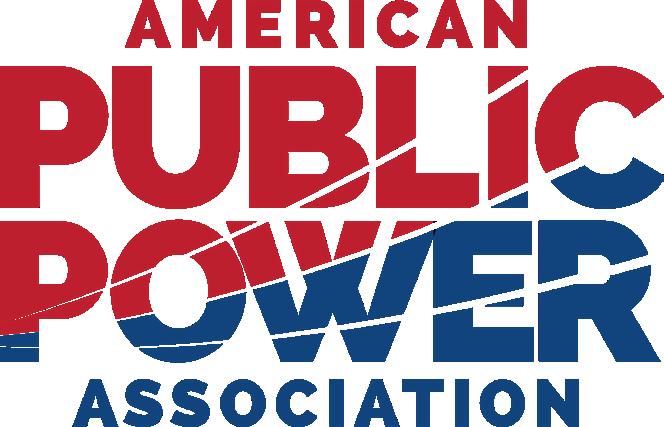
utilities based on four critical disciplines that form the foundation of exceptional utility service:
Reliability. Beyond simply keeping the lights on, NWCPUD must demonstrate sophisticated methods for collecting and analyzing reliability data, maintaining mutual aid agreements for emergencies, implementing comprehensive disaster management plans and establishing robust cyber and physical security measures.
Safety. Creating a culture of safety that protects both employees and customerowners is paramount. This includes adherence to industry safety standards, regular training and ensuring safety is
prioritized at all levels of the organization. Workforce development. This discipline focuses on how NWCPUD invests in its most valuable asset: its people. Through professional development, networking opportunities and succession planning, your utility ensures continuity and excellence in service delivery regardless of workforce changes.
System improvement. Looking toward the future, NWCPUD must demonstrate its commitment to maintaining system integrity and long-term planning through ongoing research, development and system enhancement programs.
While RP3 focuses on operational fundamentals, the SEP program recognizes utilities that excel in forward-thinking energy practices across four key areas: Smart energy program structure. This evaluates how NWCPUD establishes and integrates energy-efficiency and sustainability goals into its operations,
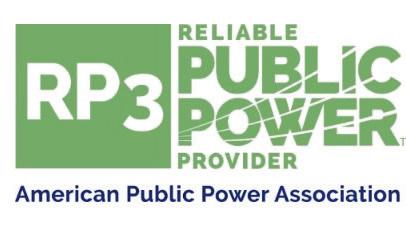
including benchmarking and research initiatives.
Energy efficiency and distributed energy resources. This assesses the variety of programs NWCPUD offers its customerowners, including energy-efficiency initiatives, demand response programs and options for distributed generation and storage.
Environmental and sustainability programs. This examines NWCPUD’s efforts to reduce emissions and environmental impacts, including tracking and evaluating the environmental benefits of its smart energy programs.
Customer communication and education. This evaluates how effectively NWCPUD engages with customers about smart energy options and gauges customer satisfaction with these programs.
In 2024, Northern Wasco County PUD achieved an impressive milestone by earning the platinum-level RP3 designation, meeting an extraordinary 96% of the required criteria. This places NWCPUD among the elite of public power utilities nationally, as only a small fraction of the nation’s 2,000-plus public power utilities has earned RP3 recognition at any level.
The platinum designation—awarded for meeting 90%-97% of requirements—sits just below the highest diamond level, 98%100%, and well above the gold level, 80%89%, reflecting NWCPUD’s exceptional commitment to operational excellence.
Simultaneously, NWCPUD was designated as a Smart Energy Provider in December 2024, joining fewer than 100 utilities nationwide that hold this distinction.
Notably, NWCPUD is the only utility in Oregon to achieve SEP designation, making it a true leader in smart energy initiatives within our state. This recognition validates

NWCPUD’s dedication to energy efficiency, distributed generation and environmental initiatives.
Achieving RP3 and SEP designations involves much more than simply checking boxes on a form. The application process demands extensive documentation, crossdepartmental collaboration and a genuine commitment to excellence throughout the utility.
For NWCPUD to earn its platinum RP3 status, teams across the organization—from operations and engineering to safety and human resources—had to work together to compile comprehensive evidence of our practices and procedures. This included gathering years of reliability data, documenting safety protocols and training programs, demonstrating workforce development initiatives and showcasing our system improvement projects.
Similarly, the SEP designation required our teams to document NWCPUD’s smart energy initiatives across multiple departments. Staff collected information about energy-efficiency programs, researched environmental impacts, documented distributed energy resources and gathered evidence of customer communications and education efforts. These application processes represent significant investments of time and resources for NWCPUD, but they also provide valuable opportunities for self-assessment and improvement. By examining our practices against national standards, we identify areas where we excel and opportunities to enhance our service to the community.
As a customer-owner of Northern Wasco County PUD, these designations translate to tangible benefits:
Higher reliability. NWCPUD’s systems and processes are designed to prevent outages when possible and restore power quickly when interruptions occur.
Enhanced safety. Your utility maintains rigorous safety standards that protect workers and the community.
Forward-thinking programs. From energy-efficiency rebates to distributed energy options, NWCPUD offers innovative programs that help you manage your energy use and costs.
Environmental stewardship. Your utility’s commitment to sustainability helps reduce our community’s environmental footprint. Better customer service. NWCPUD’s customer engagement and education initiatives ensure you have the information and support you need to make informed energy decisions.
Lower operational costs. By implementing industry best practices, NWCPUD operates more efficiently, which helps keep rates lower.
Northern Wasco County PUD’s designation achievements demonstrate our commitment to providing you with reliable, affordable and sustainable utility services. As technology evolves and industry best practices advance, NWCPUD will continue working to maintain and improve upon these high standards.
The next time you see the RP3 and SEP logos, you can take pride in knowing that your community-owned utility ranks among the best in the nation, delivering exceptional service today while planning for a sustainable tomorrow.
This article is the first in a two-part series about NWCPUD’s prestigious RP3 and SEP designations. In an upcoming issue, we’ll dive deeper into the specific programs and initiatives that helped us earn these recognitions, highlighting the innovative work happening right here in our community. n
For more information about the American Public Power Association RP3 and SEP programs, visit publicpower.org.
Kyle Trojan Kline took his daughter fishing in September 2024 and came away with a whopper of a catch while fishing for Burbot near the dike in Fairbanks, Alaska.
“It is almost 25 years to the date since (Ruralite) published (my son’s) first fish picture,” says Jodi Trojan, Kyle’s mother. “I just thought it was a very cool coincidence.”
To submit your photo, email a JPEG to photos@pioneer.coop. Include “Before You Go” in the subject line and share a bit about what inspired you to make your photo. n
Kyle Trojan Kline’s 3-year-old daughter holds up her catch as best as she can during a fishing trip. PHOTO COURTESY OF JODI
TROJAN
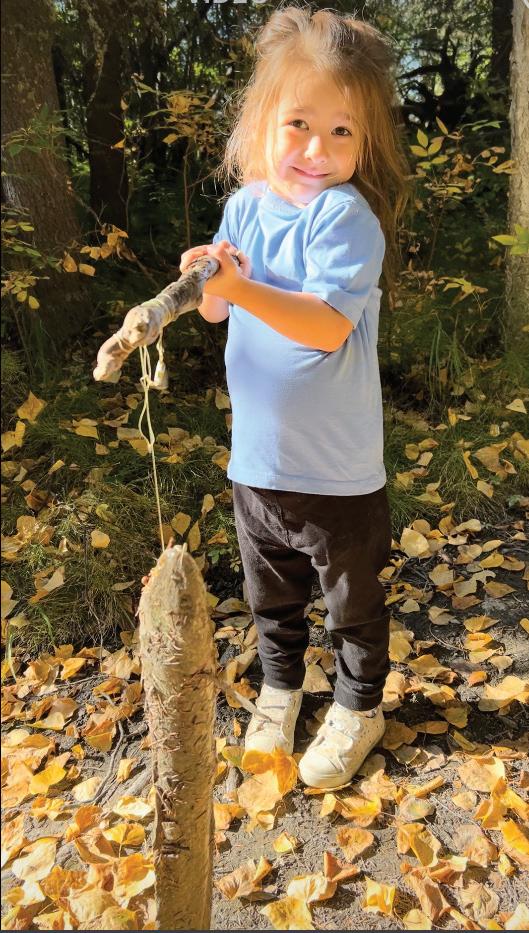
Want a fresh take on salads? More than 250 readerrecommended recipes are listed in an 8½-by-11-inch indexed book for $8, postage included.
To order by mail, send payment and number of cookbooks wanted along with your name and address to Ruralite Cookbooks, P.O. Box 1306, North Plains, OR 97133.
To pay with Visa, MasterCard, Discover card or American Express, call 503-357-2105.
To order online, visit www.ruralite.org. Allow two to three weeks for delivery.




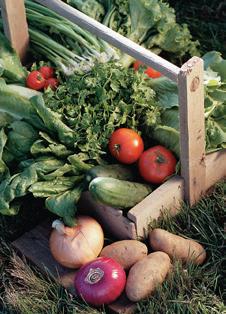








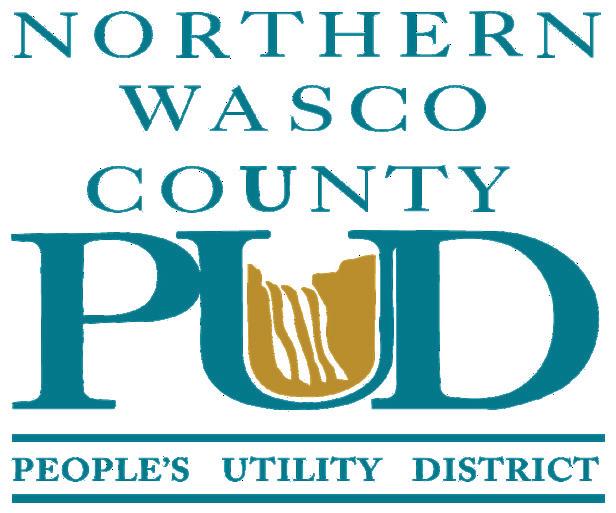
2345 River Road
The Dalles, OR 97058
541-296-2226 Fax 541-298-3320 nwascopud.org
Board of Directors
Daniel Hammel
Roger Howe
Wayne Jacobson
Greg Johnson
Scott Taylor
Manager Roger Kline
Board Meetings
Usually 4 p.m. the first Tuesday of the month at the PUD office, 2345 River Road. The public is always welcome.
Our Mission
To provide reliable, competitively priced energy and related services that benefit our customers, in the tradition of public power.
Our Core Values and Beliefs
Local citizens championed and fought to create our People’s Utility District. They believed—and we believe—in the public’s right to own and control its electric utility.
Today, our values are a legacy from our public power heritage, as well as guideposts for a changing future.
We believe in:
X Safety
X Integrity
X Customer Service
X Respect
X Operational Excellence
X Sustainability
OR-3
As we welcome summer in our beautiful Columbia River Gorge, many of us are eager to tackle outdoor projects. Whether you’re landscaping your yard, building a new deck or simply planting a garden, June is National Safety Month. It’s the perfect time to remember two critical safety practices: Call before you dig, and always look up for power lines.
Every summer, we hear news about contractors or homeowners accidentally striking underground utility lines. These accidents can result in service disruptions, costly repairs and serious injuries.
The solution is simple: If you’re planning to put a shovel in the ground, call 811 at least two full business days before you start your project. This free service connects you to the Oregon Utility Notification Center, which coordinates with utility companies to mark underground lines with color-coded spray paint or flags.
Those colorful markings you see on streets and yards aren’t just for decoration. They’re a vital safety measure showing you exactly where underground utilities are. Wait until you see the spray paint or flags in your yard before rolling up your sleeves and getting to work.
While we’re often reminded to look down for underground utilities, it’s equally important to look up for overhead power lines. These lines can easily fade into the background of our daily landscape, but coming into contact with them can be deadly.
Overhead power lines require at least 10 feet of clearance in all directions. This applies to distribution lines along roadways and service lines that connect to your home. Even greater clearance is required
for large transmission lines and towers.
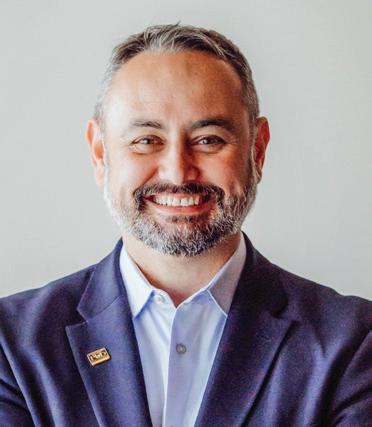
When working outside, check for overhead lines before using ladders, pool skimmers or pruning poles. As you move around your property, carry ladders and other long items horizontally whenever possible to avoid accidental contact with lines above.
Tree trimming near power lines should never be a DIY project. Leave this dangerous work to certified line clearance professionals who are specially trained to work safely around high-voltage electricity. If your project involves working on your roof, exercise extra caution, especially during windy conditions. Be mindful of service lines that connect to your home.
At Northern Wasco County PUD, safety is one of our core values. As your community-owned utility, we want everyone to enjoy a productive and safe summer. Taking these simple precautions protects you, your family and your neighbors.
One final safety reminder that’s especially important during summer storm season: If you ever encounter a downed power line, always assume it’s energized. Stay at least 50 feet away, keep others clear of the area and immediately call 911. Never attempt to move or touch a downed line, even if you think it might be deenergized.
As we enjoy the longer days and warmer weather of the season, let’s make safety our top priority. Look up, look down and stay safe!
Manager Roger Kline